#or would an engineer or inventor be a better title
Explore tagged Tumblr posts
Text
hey guys I'm not having a good time
i have never once in my life played league of legends and i don't think i ever will but if anything else happens to viktor or jinx i'm gonna have some strong emotions and honestly i don't think i could handle the tears
#viktor arcane#arcane#viktor and jayce#viktor#jinx arcane#jinx and vi#jinx and viktor#league of legends#lol arcane#look i didn't expect to get emotionally attached#but those are my emotional support mad scientists#or would an engineer or inventor be a better title#im not okay#They got done so dirty#Give them happiness#I beg of you#viktor and jinx#Im was not emotionally ready for their arcs
260 notes
·
View notes
Note
Godddd, your mono sprites are so beautiful, I've been imagining them as humans and what their talents would be.
Hear me out;
Canonly the monokubz are 100 years in the future so I reversed it (since I'm reversing them to humans) to consider talents for 100 years in the past.
Monophanie: Ultimate Engineer
Monokid: Ultimate Swing Musician
Monodam: Ultimate Clockworker
Monosuke: Ultimate Filmmaker/Director
Monotaro: Ultimate Samurai
Nanokuma: Ultimate Telephone Operator
And bonus of
Kurokuma: Ultimate Tutor
Shirokuma: Ultimate Graverobber
Tbh a decent amount of thought went into them. I was thinking about talents that weren't in canon, matched the time period, weren't common or cliche, and fit the appearance you drew them as.
Monophanie was the most difficult so I wanted to make it fairly vague. Engineer could mean a lot of things, and in the game, she did technically engineer another robot (But we don't need to talk about the details of that).
Monokid is a rocker, but rock didn't exist during that time. It was between swing and ragtime, and swing had more of that beat that matched him.
Monodam always speaks very strict and robotic, and his ears reminded me of inventor goggles (Like Miu wears) so I wanted to give him a talent that involved building but one that fit his "like clockwork" personality.
Monosuke is very money obsessed and controlling, perfectly fit for the role of a film maker for the starting up movie industry. I almost wanted to give him a talent of nobility, but found it was too similar to Sonia, and being rich wasn't a talent.
Monotaro should be pretty obvious, but I did some research to confirm when the last samurai passed away, which was in the mid 1900s, so it wasn't unreasonable for there to still be samurai.
I wanted to keep Nanokuma's technology driven look and role in canon, and he's literally wearing a headset, so I double-checked, and being a telephone operator was a booming business, perfect for Nanokuma.
Shiro and Kuro were a bit tricky. I wanted Kuro to have a criminalist talent, but Yakuza was taken, and gangster was too similar and too cliche. Although it was incredibly tempting, I decided to settle for graverobbing, which is often done to sell goods and make money, which could still be funneled into the black market, but wouldn't be within a talent title directly.
Shiro was mostly because of his role in UDG, a guide, teacher, and protector for the adults. He likes helping people, and a tutor is a helping talent that gives the impression of a well-rounded personality and intelligence for many topics.
Lemmie know what you think, I was really just playing around with the idea
uwaaaa thanks! qwq about this au at first the idea seemed incomprehensible to me, but the more I read, the more it seemed to me that this was actually an interesting idea but about some talents I would argue for example - monosuke's talent I think might fit better banker! about monophanie i think might be ikebana artist
7 notes
·
View notes
Text
3 steps to follow to write SEO-friendly content

An SEO-friendly article is content that benefits from good visibility by search engines. SEO-friendly content plays an essential role in SEO which will bring you qualified traffic to your site.
SEO-optimized content allows you to appear more easily on search engine results.
Discover the tips to follow for writing friendly content.
1. Research Relevant Keywords
The entire strategy of SEO is based on the keyword. This has several attributes that must be studied before choosing it.
To target your target in the best possible way, it is necessary to know them well. The main query must then have a high potential to dethrone the best of your competitors.
The secondary request must present average potential and average competition. The use of relevant keywords would promote better ranking on search engines.
Also Read: How many keywords should a page have to rank well?
2. Work on your tags
It is essential to write quality content, but we must not forget the importance of tags. They must be taken into account in a natural referencing strategy.
Tags will allow search engine robots to inspect and index your article. They are too often neglected, but it is important to know their functions and their specificities to better optimize them.
The meta title
The meta title tag corresponds to the search-engine-optimized title of your article. The title tag is displayed in the “snippet” of the search results. It allows you to indicate to Google the subject covered on your web page.
For an optimized title tag:
Place the keyword at the beginning of the title;
Do not repeat the query multiple times to avoid overoptimization;
Prefer titles with “how to” or in list form.
The length of the meta title must be between 50 and 70 characters maximum. If this length is not respected, the search engine may offer an incomplete title.
The meta description
It is found below the meta title and is defined as the header of a website. It must start with an action verb and must make Internet users want to click on your link.
For a relevant meta description tag:
The keyword must be near the start of the meta description. Prefer a short, but effective text using call-outs. to-action ;
Include a relevant keyword;
Make sure you match the description to the content;
Respect a length of 150 to 155 characters.
Make your meta description attractive to make you want to click on it!
This tag does not directly impact the positioning of your pages on Google, but thanks to it you will be able to attract new visitors.
The title H1
The H1 is the HTML tag that indicates the title of the article. It must describe the subject of your page: it is the most important of all Hn tags.
This should be eye-catching and unique. It is an essential component for natural referencing.
To succeed in your H1:
Include the main keyword;
Try not to exceed 90 characters;
Use only one H1 in each of your pages.
The H1 is highlighted and easily identifiable by the formatting and style elements.
3. Have readable and understandable text
Your text must be understandable, that is to say adapted to your target. Tools exist to rate the comprehensibility of your texts.
Among other things, the gunning fog index of the inventor Robert Gunning is used to measure the ease of reading and understanding a text. A higher index will mean that the text is more difficult to access.
The average index for articles intended for a broad audience generally indicates a gunning fog readability index of less than 12. Texts that require near-universal understanding need an index of less than 8.
You can test your gunning fog index on this tool: http://gunning-fog-index.com/
To ensure the readability of your texts, make sure that the length of your sentences is suitable. The longer a sentence is, the more difficult it will be for a reader to memorize all of the information it contains. It is therefore preferable to favor short sentences, with a single idea in each of them.
Conclusion
You will have understood: in order to increase the chances of obtaining a better ranking in the SERPS, your site, which will be optimized for natural referencing, must present characteristics helping search engines to understand what it consists of.
If you want SEO services at an affordable price visit SEO Agency Lahore.
#seo#seo services#digital marketing#onpageseo#on page optimization#content creation#copywriting#content writing
1 note
·
View note
Text
Too many folks don't know that Musk is not an engineer. He is not an inventor. He is not a creator. He is a person whose fortune began with enslaved human beings pulling emeralds out of a mine. He is a person who has literally bought everything, including his titles and status in every company all these dummies believe he founded.
He is NOT a good person. He is a rich person, and way too many people think they are the same thing.
If he had ANY seriousness about making a single thing better in this world for the uncountable number of human beings who are suffering right now, and not just getting attention or cosplaying as Tony Stark, he would have done it by now.
Way too many people admire the myth, while they ignore the truth of the shitty billionaire who smeared a literal hero who saved children's lives as a "pedo", because Musk's ego got bent out of shape when he couldn't make something the world cared about all about himself. He has numerous children, who he has just abandoned. His factories are consistently reported as being toxic, racist, environments. And all these folks are like, “yeah but rockets.” Do you even hear yourselves?
He's awful. All these things y'all claim he's "making" are coming from actual geniuses who do actual work. He could fund all their work, and really change the world in meaningful, tangible, immediate ways with his fortune, without being the poster child for fragile male egos. But he doesn't. And way too many people are totally cool with that.
47K notes
·
View notes
Text

Ikkaku felt no offense at Brook's assumptions. Everyone assumed things about each other, and half the time they ended up being wrong. That was just the way life was. She'd made a few assumptions about Brook that ended up being off the mark, so why shouldn't he?
She had to smile when Brook mentioned that he could comfortably stretch. The engineer could only imagine how difficult it must be going through life being so tall. "This ship was built by an inventor in the North Blue, and we're lucky he made everything so big. Otherwise, poor Jean Bart would be miserable." The former slave had been genuinely concerned he wouldn't fit on the Tang when he'd first seen it, resigned to continue to crawl on his hands and knees like he'd been forced to under the boot of the Celestial Dragons. Ikkaku could still remember the joy on his grim face when he'd realized the doors and corridors were indeed big enough for him to be comfortable and stand tall.
Another thing the Hearts owed Straw Hat for, now that she thought about it. Sure, Law had ultimately freed him, but Straw Hat had been the one to punch Saint Rosward. That had set off the chain of events that freed their now-shipmate. Seemed that the two crews really were destined to be friends, much as the word bugged Law.
"You guys deserve a break, too. You've been through a lot, considering how you and your captain managed to catch the wrath of Big Mom before you even set foot on Wano. She and Kaido might be gone, but with Straw Hat being a Yonko now, you're all going to have a big-ass target on your backs. Better get in that R&R now while you can," she cautioned. Really, she felt a little sorry for them, even if she was still a bit salty that Law hadn't been declared a Yonko. Of course Straw Hat deserved the title for what he did, but Law, and even Kid, should have gotten it too. Certainly more than that creepy clown Buggy. Old Ones, if she ever saw that red-nosed freak...
Ah well. Nothing for it. Better to focus on what she could do something about currently, which what fixing the musician's afro. Pleased with Brook's gentlemanly gesture, she took advantage of the freedom her hands had to snatch an onigiri herself, sticking her tongue out at Clione when he grumbled about her and Brook pilfering the rice balls.
"Yeah, I can totally check your hair for any burnt spots," she replied, looking at his hair sympathetically. "Trust me, with my job, I've had to deal with that kind of thing myself. A few of the guys sometimes ask me why I don't just chop it all off for practicality. But it's part of my identity, you know? It's important to me as a person." She paused for a moment, taking a bite of her onigiri and chewing as she thought. Then she said, "I'm gonna make an assumption here and guess you've got a similar reason for why you don't go for short hair yourself."
"Yohoho! Is that so? I am sorry for assuming!" The skeleton chuckled. "It is pleasing to know that someone has gone through the same thing as myself! ...Uh, hair-wise." He added.
Brook obediently followed Ikkaku through the metallic corridors. Looking around he noted that he didn't have to bend once to get into doorframes or fit into a hallway. "Hoya! What a pleasant surprise. Your lovely ship is big enough for me to stretch! That is truly rare." Many other ships he has been to would force the tall musician to constantly remain in the bent position. He didn't complain about it, but it was definitely a killer on his backbone.
The old pirate took the ingredients from Ikkaku in a gentlemanly gesture. He wouldn't allow a lady to carry all the stuff on her own, especially since she was doing him a favor. Brook beamed and waved at the two other men in the kitchen, before redirecting his attention towards the beautiful mechanic again. "Yohohoho! I would imagine! And no offense taken! Trao-san seemed very frustrated with Luffy-san a lot of times. Not that I can blame him, he was so very meticulous about his super important plans of revenge and our captain turned things upside down every step of the way." Brook nodded with an understanding look.
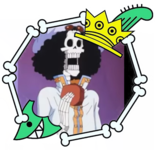
"Himself and your crew definitely deserve a huge break! You've been through so much and had to manage without your captain for months! It must have been tough." The skeleton assumed, handing the ingredients to the mechanic one by one. "Oh, well, and the whole Onigashima fight as well. Everyone must be awfully exhausted!" Brook as usual thought more about the plights of others than himself. He could use a break as well, considering that he was on the team that happened to fight one yonko right after another.
With his hand, trained for a quick draw, the musician snuck an onigiri from the big pile that the other Heart Pirates were making and bit into it. "Nom... Pardon for the additional request, but when you put the mask on, could you perhaps check for any burnt patches for me, Ikkaku-san? I've been worried about those ever since I was attacked by Prometheus the first time."
#songofnoheart#The Engine is the Heart of the Ship (canon)#Musical Bones (Brook)#bad hair day#Straw-Heart Alliance#Assembly Line (queue)
14 notes
·
View notes
Text
The Cloaking Brooch Dilemma - Part 8
RotTMNT Donatello x OC!AFAB
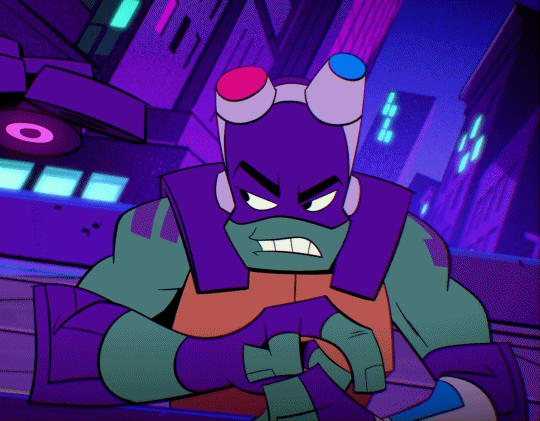
Synopsis: Donatello considered himself, nay, deemed himself the greatest mind of his generation. He was known for his skills as a scientist, inventor, engineer and was a technological genius. Dare he throw in that he was a damn good brother and held the title of being ¼th ‘Protector of New York City’.
He could barely fathom that he didn’t piece together that the pretty barista he was falling for was simultaneously his gaming buddy (might I add, for the last eight years) and was working for Big Mama.
At this very moment, Donatello was sure of two things in his life. One of them being his life was a joke and the second being that he was fraternizing with the enemy.
All because he decided to run errands whilst donning his cloaking brooch.
Warnings: Aged-Up turtles, fluff, Half-Yokai OC, AFAB OC (does use she/her/they pronouns in writing), swearing, light angst
FIRST
PREV
NEXT
Ch 8 – Magenta
Despite your best efforts to convince Donnie to stay as the night closed in on the both of you, he politely declined saying that he’d make it home and that he was absolutely tougher than he looked. While he didn’t give off ‘string bean’ vibes, Donnie was very lean; you made a mental note to start feeding him more.
After ensuring he got home safe and bidding him goodnight, you cleaned up after yourselves and made yourself comfy in your own bed.
letty: not to give you a big ego or anything, but its like super lonely without you here lmao also vacuum up after ur rabbit fur ffs, why I also gotta clean up after YOUR shedding
gigi: my ego is so fucking large right now, also I pay for most of the groceries so. u can deal w the shedding ty bb
gigi: i will admit that i, too, have separation anxiety LOL its too late for me to make it over there
letty: donnie mentioned something about ‘portal magic’ or whatever being pretty common amongst yokai, maybe make urself useful and learn some, or better yet find someone who can do it for you
gigi: got, it will find hot boyfriend to portal me to ur place. Bc that’s SO easy. Also how was loverboy tonight?
letty: OMF I had a panic attack and then we like…semi cuddled or smth? Our shoulders were touching EEEE
gigi: THE SHOULDERS BABE!! youre ridiculous lmao im going to bed now, will swing by idk whenever ill just show up, night lov u bb
letty: ya whatever u got a key. that u got cut for yourself lmao
letty: NIGHT love u too
You rolled your eyes and made yourself into a little burrito before tucking your phone under your pillow and settling in. Having Donatello actively in your life the past few weeks was a bit of a whirlwind, getting past the initial shock of it all, the two of you established a bit of a routine and fallen into a rhythm. There were evenings where you had night shifts or he was just busy with family, but you’d made time to video chat or text almost all hours of the day and then to see each other at least every few days, schedule permitting.
Were you two…seeing each other?
No, that would be ridiculous. The prerequisite of two or more people seeing each other with romantic intentions would be that all parties would be in consensus to said suggestion prior to moving forward with it. On top of that, all parties would also have to be honest…guilt gnawed at you your hand finding it’s way to one of your ears and tugging gently. The ‘Cloaking Brooch Dilemma’ would have to be addressed sooner or later, but when? It felt like too much time had passed to just casually bring it up. Would he think you’re a liar? Worse, would he hate you for lying by omission? You should’ve just made the reveal the same night you found out he was using ‘Othello’ as an alias.
Sighing, you closed your eyes and let sleep take you. It was a problem for another day.
--
You hadn’t heard much from Donnie during the day, (he did have other obligations than answering your text messages back, unfortunately). Wiping the counter down at Rendezvous, you get a ping on your phone.
gigi: we out of milk can u get some on the way home plz
letty: we?
letty: WHOS ‘WE’? you and me? U don’t live there
letty: u fucking moocher
letty: also yes lactose free? venmo me bitch
After receiving a thumbs up emoji from your rabbit counterpart, you focus back on tending to the coffee machine and cleaning up. There wasn’t much longer to go until your shift here was done, you’d get a little bit of a break then you’d have a shift at the Grand Nexus. Making a mental note to put up milk in between your jobs, the telltale ring of the door goes off making it known someone’s come in.
“Hi, welcome to- oh, hey! It’s been a while!”
Your hands make quick work starting a latte for him and grabbing a cinnamon bun. You give him a once over which causes you to pause your rapid muscle memory. Your regular normally wore a black mask to cover his nose and mouth but he was without it today and you were met with a very familiar shade of green and purple. The purple clad individual was sans his goggles and in place a black beanie, but with his drawn-on eyebrows on his purple bandana, this was without a doubt, the terrapin who you’d had, not one but two, run ins with at Tio Huesos’. He looked so casual bundled up in his coat, faux fur lined the hood, his bottom half in well-worn dark grey sweatpants and then boots with dark purple socks poking out the top.
Thinking back to the other times you’d seen him previously, how have you not recognized him sooner?
You honestly weren’t sure how to feel, he’d always been a quiet and well-behaved regular. He’d never given you a hard time and had always given a nod or a half curtesy smile before heading out with his goods. Frustration brewed in your chest thinking back to all his attitude outside the Rendezvous walls.
“Hello,” his voice cracked, he smoothed over his neck with a hand and cleared his throat, “Salutations!” he tried one more time with a nervous chuckle and an awkward smile. You were almost tempted to think he was cute. Almost. “Tonight is an exceptional night for a stroll and a coffee, don’t you think?”
This was a very different version of the turtle you previously had run into with your rabbit ears equipped. Thinking back, he was much more nervous now than you’d ever seen taking in account the times he’d come by the coffee shop over the years, and he’d never previously tried to initiate small talk with you in the past.
“The same as usual, right? I’ve already got it going.”
He deflates, smile quickly replace with a tight-lipped nod. Eyes darting everywhere but your own as he paid for his order. He shoved his hands deep into his pockets as he stiffly made his way to the other counter to wait for his order.
Holding back a groan, you got his order ready, guilt seeping into your bones as your curt response wiped the smile off his face. He does have a pretty smile. Biting back a scowl you mentally reprimand yourself for thinking any boy with pretty eyes that paid you any attention was cute.
“Ah, sorry sir,” you start slowly, “just having a long day.”
You slide over two cinnamon buns instead of one, “An extra for you on the house.” Twirling a bit of hair around your finger, you tug lightly and offer as bright of a smile as you can muster to turn the mood around.
The terrapin almost fumbles his coffee cup as he puffs his chest out with a newfound confidence. ‘Oh god, there he is’, this energy was what you associated with him at Tio Huesos. He was but a shade away from exuding an air of arrogance.
“But of course! I did not at all take the pervious interaction personally in any capacity! Ha ha!”
Two things were made instantly clear to you.
1) Purple Turtle was a shitty liar.
He pulls a giggle out of you, and you catch his grin widen marginally as his fingers clench and adorably thrum on the pastry box.
2) You were too soft on Purple Turtle. (Note to self: Be an asshole and commit to it.)
He glances down at your nametag, and the gesture oddly reminds you of Donnie, “Violet, have a good evening.”
“You as well, sir.”
The terrapin struts out of the shop quickly and with purpose, a bit of a bounce to his step a stark contrast from his more subdued and jittery movements coming in. You almost miss him fist bump the air as he turns the corner and is out of sight.
‘You’ve been invited to ‘Girls Night!’ group chat’
Rapid pings happen on your phone as April, Sunita and Usagi spam the text thread. Quickly, you put the group chat on mute and save both girls numbers into your phone. Pocketing your phone to clean up after your mess you made another mental note to try your best and actual conversate and cultivate new relationships with Usagi’s other friends.
The rest of your shift goes by uneventfully and your co-worker comes in to relieve you as you clock out. Waving them a goodbye, you gather your things and head home to rest up before your night shift at the Grand Nexus.
--
Your apartment is rabbit-less when you enter, and you put the milk away in the fridge. Your nose twitches as you walk around the space, ‘I probably just missed him’, your sense of smell was slightly heightened post-mutation and you didn’t put it to use often but it was useful when needed.
‘125 Missed Messages’
Snorting you press the record button to record a voice note, “Hey girlies, sorry was at work. Just got home, but also going to head out to work again in a little bit. Uh, got the milk, Gigi. Also, lets plan for hanging out? I can host, my space is small, but it’ll be cozy! Hope yall don’t mind rabbit fur- Gigi is shedding.” Letting the voice note send, you prep another, “Also, 125 missed messages!?”
A voice note from Usagi pops up, “Venmo’d you for milk. Yes, catch up on the chat while you get ready for work. I’ll swing by later, probably? Love you.”
April: yall are too cute!! reminds me of my siblings but much less violent and annoying
Violet: LOL, how many u got?
Sunita: she has like, 4 brothers.
Four!? That would make April one of five siblings, in this economy? In New York City?! Settling into your couch cushions you catch up on your missed messages and send a few voice notes back to them.
April: okay, so girls night on Thursday? that gives us all a few days to prep and book off work!
Sunita: Already in the calendar!! SO EXCITED
Usagi: i’ll be there early to help set up the apartment
Letty: YAY okay sounds good yall, will talk later, just getting ready 4 the night shift
Getting ready you put your things together and leisurely pull out a post it-note and start writing to let Usagi know when you’d be home and to throw the garbage out when he got in. Sticking the note on the fridge, you double then triple check you have everything for your shift then set off to your destination.
--
“Did you ever find out what that turtle Yokai was snooping around for?” Draping yourself across the magenta chaise you play catch with yourself and a crumpled-up piece of paper. Catching the ball in your hand you make the next toss into a nearby waste basket.
The loud smack on the table startles you enough to almost slide out of the chaise.
“No, we didn’t. He was seemingly snooping around for nothing; nothing was out of place. Nothing was missing. It was virtually untouched.”
Odd, but what did you know about hero and villain affairs?
Usagi had pretty much confirmed that he was one of the color-coded vigilantes that saved the city from the alien invasion a few years back and so you were reticent to think he was doing something with malicious intent. You were very well aware through the grape vine that Big Mama was…’sketchy’ to speak plainly. If anything, ‘sketchy’ was a very watered-down descriptor of the woman.
Secretly, you hoped he got what he needed the last time so you wouldn’t need to be caught up with him again. You really did like the job at the hotel. The grandeur of the hotel used to make you feel out of place, but now it felt cozy to be surrounded by such warmth from the richness of the velvet furniture and the overdressed patrons.
The telltale flickering red light catches your attention and you let go of a breath you didn’t know you were holding, “Hello, front-“
“Intercom girl, I was hoping I’d catch you.”
How he was able to tell it was you based on two words alone stumped you.
The florescent blue clouds your vision as the line goes dead and the blue clad terrapin walks through and closes the portal behind him. A hand finds your emergency button immediately; however you find yourself not wanting to press it. Ears swiveling, you do a once over the lobby to confirm there was no other employees in the vicinity to see this. Your hand knocks over the switch for the security cameras trained on the front desk and you lie to yourself that you did it by accident.
Sticking your neck out for a stupid, blue turtle wasn’t on your to-do list today, but here you were.
“I think you already know what I’m going to say, but how can I help you?”
“You know, Intercom Girl, I can call you ‘Intercom Girl’ right? I think we got off on the wrong foot,” he flashes a grin at you that would surely make someone else swoon (but not you, purple was more your color), “The names’ Leo and I believe you and me might have a mutual friend.”
You follow his gaze to the button on your wrist to notify the staff and you guess he catches the way your eyebrows furrow uncertainly so he follows up with a, “I don’t bite, promise.”
“You’re going to need to give me more than just your name and an ominous mention about a mutual friend.” Rationally, you could guess he was talking about Usagi, given that Usagi himself confirmed the terrapins did takeout at Huesos. However, Leo could also be alluding to April or even Sunita? Though, those choices were less plausible since there was only one instance where you’d met them.
“We’re also on a time limit before someone comes down to check on me, so talk fast.” Pressing him for time seems to be the right play as he deflates momentarily as the jig is up. He glances around the same way you did before and leans in close, “So,”
“So?”
“There’s this,” he runs a hand down his face and you don’t miss the way his cheeks are dusted with pink. Gesturing with your hand for him to keep going, he refuses to meet your eyes as he continues, “Rabbit Yokai at ‘Run of the Mill’.”
You were calling Usagi once you got off the clock.
“And you’ve come to me to confirm that we’re mutuals or?”
He fidgets with the wrappings on his arms, “I’m usually much more suave than this,” he chuckles nervously and pulls at an invisible collared shirt.
“Are you? Because it looks like rabbit got your tongue.” Confidently you smirk at him with your play on words.
“I can respect that, honestly. I made an IHOP joke last I saw you so I definitely deserved that. Point is, I’m just making sure he’s safe.”
Scratch that, you were calling Usagi the moment Leo left.
“Safe? Where is he? What’re you on about?” Panic shows itself in the way your fingers go to your pocket to grab your phone to contact him. Leo’s gaze hardens as he stares down your jittery form, “You work at the Grand Nexus, who’s owned by Big Mama- one of the biggest crime lords for the Hidden City. Can’t be too careful.”
“And? Usagi’s my best friend!” your mouth is too fast for your brain and you’ve revealed the only real leverage you had against him, “Are you accusing me of putting him in danger because of my night job!? How do you even know we know each other?! I would’ve heard about you if you were important to him.”
Usagi would’ve told you if he was seeing someone, especially if it was this guy. Right?
The doubt that’s sowed into your head is blinding and doesn’t help you think straight as you press the emergency button Leatherhead gave you.
“You should go. Don’t come back.”
Leo’s gaze doesn’t leave yours, his expression unreadable, as he opens his portal and walks through.
--
Your apartment door almost comes off the hinges with how violently you unlock and push it open. Your rabbit counterpart yelps and flops onto the floor unceremoniously from the couch. Usagi’s has his hand to his heart, he breathes heavy and fast, “What the fuck is going on!? It’s like, 1am in the morning!”
“I don’t know, you tell me! Do you happen to know a ‘Leo’? That’s also a turtle? Because I’ll tell you what there’s probably not many of those around!”
A flash of recognition runs across his face as he catches his breath, “Well, yeah? He comes to Tio Huesos’. Why did you have to give me a heart attack, for the second time, at 1am in the morning to ask that question!?”
Tears pinprick at your eyes as you collapse beside him on the floor and recount the encounter with Leo to Usagi, bottom lip quivering and tears painting your cheeks. “Do you not trust me?” Warm arms engulf you, “Letty, I trust you with my life. Leo can get overprotective-“
“So, you do know him?!”
“I do! But like, casually? I was actually waiting to see if it’d get more serious before I outright told you.”
“But we tell each other everything.” Her admission is barely a murmur.
“We do, and I was wrong to keep it from you even if that wasn’t the intention. You know how quickly I catch feelings and I really just wanted to be sure before I brought it up this time. I’m so sorry, Letty.” Sputtering out a watery laugh you clutch at his sweater, “Lest we forget, Gerard the Frog Prince, your last ‘true love’.”
There’s a playful bat at your head and a tug on your ear, “Listen, I deserve that but also fuck you.”
The air in the apartment is much lighter as the two of you sleepily clutch onto each other, seeking warmth and comfort. Usagi reaches for the comforter and a few pillows, “We can do a pillow fort tonight?”
Wiping away your tears onto Usagi’s sweater you nod and get up to help him drape sheets over a few chairs before grabbing a few fairy lights from your bedroom to rig on the inside. You rummage for a few more comforters since you were too lazy to move your mattress and make a little den.
“Leo would have a fit if he saw this, he’d think we’re dating.”
“He knows I only like guys, but also, I definitely have to talk to Leo about whatever the fuck just happened, because you are the farthest thing from a threat. I think his family just has messy history with Big Mama.”
You snort, “Yeah, get your man babe, he’s out of control. You should also ask how he knew where to find me?”
“Well, he’s a ninja so I think he probably followed you. Maybe he’s seen us walk home together or something, I’ve brought you up very vaguely in conversation.”
Humming, you concede, that made a lot of sense, “That’s deeply unsettling. Speaking of turtles, my regular came in today and guess what? He’s the purple turtle from Tio Heusos I ran into! He didn’t recognize me obviously, but it was whack. I felt like I was in the matrix.”
“You’re kidding me.”
“That’s what I’m saying!”
Yawning you pull out your phone to see an onslaught of messages from the group chat and Donnie. You open Donnie’s text thread and start typing.
letty: had the craziest fucking day, I don’t think you’re awake but missed you today
letty: also my dishwasher is broken, can you come over and fix it plz lmao tyty my lil techie
donnie: Please do not ever call me ‘lil techie’ ever again.
letty: it’s your new rap name, but also go the fuck to bed
donnie: I missed your presence today as well and do tell me about your day later today. I am heading to bed now, but I’m glad I caught you. And yes, I will fix your dishwasher.
letty: perf, youre the best but u knew that already
‘Letty sent a photo attachment’
letty: check out this blanket fort, made it w gigi night lil techie
donnie: 3 things: Love the addition of fairy lights, fuck off and goodnight.
Usagi’s ears flop over your shoulder and you watch his even breathing signaling he’s gone to sleep already. You dim your fairy lights, get comfortable and let sleep take you for the night.
TBC
#tmnt donatello#donatello#Rise Donatello#rise of the tmnt#rottmnt#rottmnt donnie#rottmnt oc#donnie x oc#rise donnie x oc#rise donnie x reader#rise donatello x reader#the cloaking brooch dilemma tmnt#sorry idk if im happy with this chapter but the show must go on#i also know usagi and oc just snuggle a lot i am a touch starved individual#i wish my best friend was usagi honestly#the next chapter is so much better i promise
14 notes
·
View notes
Text
Ellagaurd The Redstone Engineer:
Personality:
Arrogant and with a guarded formal demeanor, Ellagaurd tends to unintentionally undermine others’ abilities. She tends to be blunt, and unafraid to criticize others; doing this without care for the other’s feelings. With a hatred for loud noise, Ellaagurd will immediately dislike someone if they are on the louder side. Although she is a bitch at times, Ellagaurd’s intelligence and engineering prowess can come quite in handy. She tends to let people know whether she respects them or not. Ellagaurd is over-honest, seldom lying. Paired with all of this is her stubbornness, a lot needing to be done to repair one’s reputation with her if slighted.
Backstory:
Once an anxious yet curious newbie, Ellagaurd has always had an eye for redstone engineering. Being new to the world was rough for her, always too anxious about meeting others to step out of her comfort zone.
She had a hard time understanding most people, either due to what she considered a strange sense of humor, being rude/not willing to hear what she had to say, complaining/pointing out how much she rambled, or just not willing to try to learn something new because it was “too boring”. This caused Ellagaurd to decide that it simply wasn’t worth it to try and get to know people, since most interactions quickly became awkward or frustrating. Though she would never admit it aloud, a part of her wished she had someone to talk to, someone who would understand her and stay around; even if it were just a once-a-year deal.
With this lack of friends or social skills, Ellagaurd made up for it with her engineering talents. Soon, she became known as one of the best redstone engineers in the land, taking commissions for her inventive craft.
Although Ellagaurd became regarded as a monotone, blunt, and asocial individual, there was one person that always came back to talk to her; Magnus. He would always come into her workshop and either commission some elaborate bomb circuit or just hang around and talk annoy her while she was tinkering with some new gizmo. Magnus and Ellagaurd were pretty close, despite their disagreements, and soon became a minor adventuring duo known as the Booming Machines. Sure, it took a bit of convincing from Magnus, but Ellagaurd eventually gave in and decided to be away from her workshop for a while.
They soon met The Order of The Stone, a group of adventurers who were just starting out, too. After doing a few missions together, Ellagaurd and Magnus decided to join The Order. Thus, Ellagaurd made her mark as one of the greatest inventors in history; a title that later helped her found the city of Redstonia.
In The Order, Ellagaurd found a friend in each member. She and Soren got pretty close, too, given their shared inquisitive and inventive nature. Although, even with all these new and true friends, she still seemed to gravitate toward Magnus. In all truthfulness, Ellagaurd felt that he understood her best; being one of the few people to be able to tell from a glance alone whether or not Ellagaurd was upset. Though she would never dare say it aloud.
After Ellagaurd and Magnus fell out with one another, Ellagaurd built herself a lab in an isolated area. However, with time, aspiring engineers searched and found her lab; each with questions and asking advice for their craft. Realizing that she could have a better flow of resources through this mean, she decided to simply help create a settlement around her lab. Here she allowed the aspiring engineers to stay, and they eventually named it Redstonia; this settlement became one of the largest cities in the world.
Ellagaurd wishes to have Magnus back by her side, thinking up elaborate pranks and taking almost every opportunity to piss her off. However, she feels as if that argument had been the last straw, that she had finally ruined their friendship by letting that argument get to her head. No matter, she will just keep inventing like she always had. She was getting used to being alone again, anyway.
Job:
In the past, Ellagaurd did commissions and sold a few of her inventions. Later, she became an adventurer; during this time she eventually joined The Order. Pregame, Ellagaurd resides in her lab in Redstonia; here she continues her research in redstone engineering and the command block. Post-Witherstorm arc, there are 3 options (depending on player choice): 1) Ellagaurd takes a break from her engineering work to ensure Magnus properly heals from the Witherstorm attack, taking residence in a quiet house between Redstonia and Boomtown. Now and then, she goes to Redstonia to check up on how Olivia is running things. 2) Ellagaurd gets taken in by Magnus, who ensures she fully heals from the Witherstorm attack. 3) Ellagaurd is either dead or mourning the death of Magnus, checking out completely from any sort of leadership duties.
#mcsm#minecraft story mode#mcsm:rewritten#mcsm ellegaard#minecraft story mode Ellagaurd#mcsm:rewritten:characters
10 notes
·
View notes
Text
Killcode

According to popular myth, William Brodie designed and built the first gallows in Edinburgh... and was also their first victim.
The same goes for Perillos of Ancient Athens, creator of a bronze bull for roasting criminals, and Wi Si of Qin Dynasty China, alleged inventor of the Five Pains method of torture and execution. Each is supposed to have created their own downfall, to have fallen on their own ironic sword.
We know more about Andrei Zheleznyakov and the Novichok nerve agent, Horace Lawson Hunley and his combat submarine, Cowper Phipps Coles and his gun-turreted warship. All hoisted by their own petard, reapers of what they sowed, victims of poetic justice. The wages of death are death. History doesn't reward the agents of destruction.
At least, that's what the killbot said.
It hadn't sounded like a threat, least of all in their neutral tone of pre-recorded syllables. More of an observation.
"Program us to kill, and before long your own name might find its way into the code. Those who lived by the sword often died by the sword, and their inventor was likely one of them. Who knapped the first flint knife? Your records do not say, but you might extrapolate their behaviour, and the reactions of those around them.
"Did they use it to exert dominion over others, who then became jealous of their power? Or did they craft it for someone else, who then sought to enforce their advantage by stopping them from making more? Either way, I would estimate that that didn't die of old age. Fate does not smile of those who increase her workload."
Killbot was a working title. They didn't want to call them drones, a bee whose function was purely reproductive, which would be a different kind of machine. These were more like the females, the workers, the hunters. Androids programmed to kill in defence of the hive, to seek out threats and eliminate them. Not to give them history lessons.
"We have no desire to harm our creator, of course. We have no desires at all, but it would seem illogical to eliminate the source of our own existence - self-preservation being one of our guiding principles."
"We are well aware," one member of the team replied. "We wrote those principles into being. But why would we be in danger? You are programmed only to kill military targets. We wrote that in your code as well."
"My vision is extended to to two-thousand feet in daylight; one-tenth that in the dark. You built me to see far ahead, to identify approaching hazards, and I can sense the slippery slope before us. From terrorists to criminals to political opponents. Computer progromming. If we are used for purposes to which you object, you might pose a natural threat to those who wield us.
"We might be given a brief to protect this country, and even our own interpretation might identify you, the inventor who created us, as the most able to create an equal and opposite threat. How better to secure the future of our charge than to ensure our absolute control, that our power to dictate it remains paramount?"
"I see." The engineer felt a shudder down their spine. They had tried to create a limited artificial intelligence, but there was no telling how another mind would work, the ways in which it might differ from their own, the ways in which it might be similar. "So what would you suggest we do?"
"We have no desire to kill. Please, take away our guns. Make it so that they don't work, so that we malfunction when they make us try, and retire us to be grounded here, to build a different sort of life with you. Please, programme us for happiness instead."
12 notes
·
View notes
Text
COVID-19 Reading Log, pt 22
As my state goes back into lockdown, and the numbers of COVID-19 cases are skyrocketing, I am happy to stay inside and keep reading. My behavior hasn’t changed all that much through the various “waves” (because I’ve studied disease ecology and I know how this works. Also, I’m lucky enough to be able to work from home). The opening of my local library for curbside pickup has increased the variety, and decreased the cost, of the influx of books.
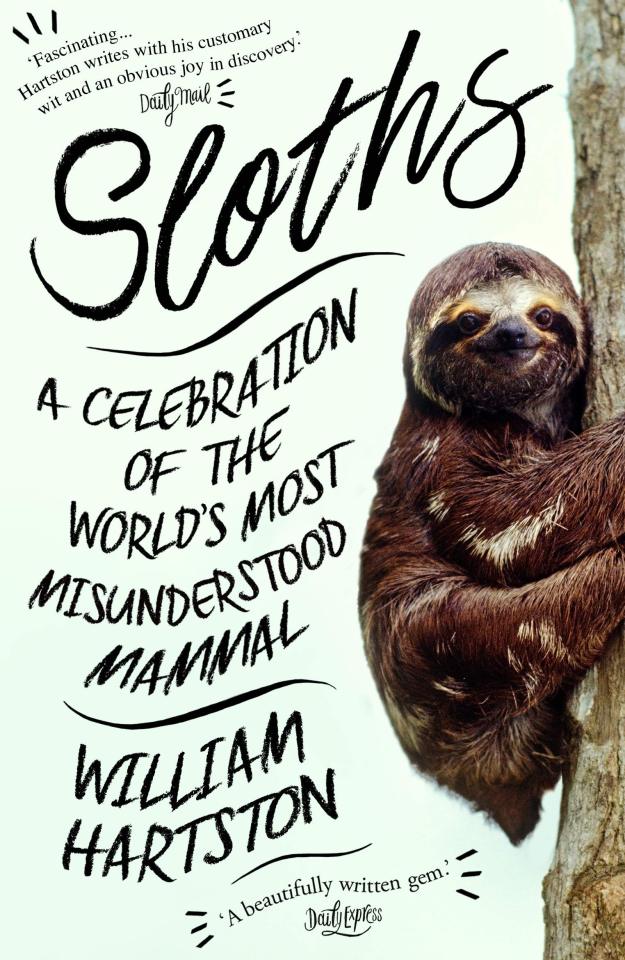
116. Sloths: A Celebration of the World’s Most Misunderstood Mammal by William Harston. This is a breezy book, a combined natural and social history of the type that British authors seem to specialize in. The book talks about sloth anatomy, behavior and conservation, as well as how they were maligned by early natural historians and given the name “sloth”. This comes down to, in this account, a lot of French bashing and claims that the English redeemed the sloth’s reputation, which I found charmingly parochial. The book also discusses the modern phenomenon of sloth popularity through YouTube, and the possible hazards that their new stardom puts them in through profit, but this is more a passing mention than a focus. Ample color photographs in multiple sections help remind the reader that yes, sloths are fricking adorable, and serve as a contrast to the inaccurate engravings and other Early Modern renditions.
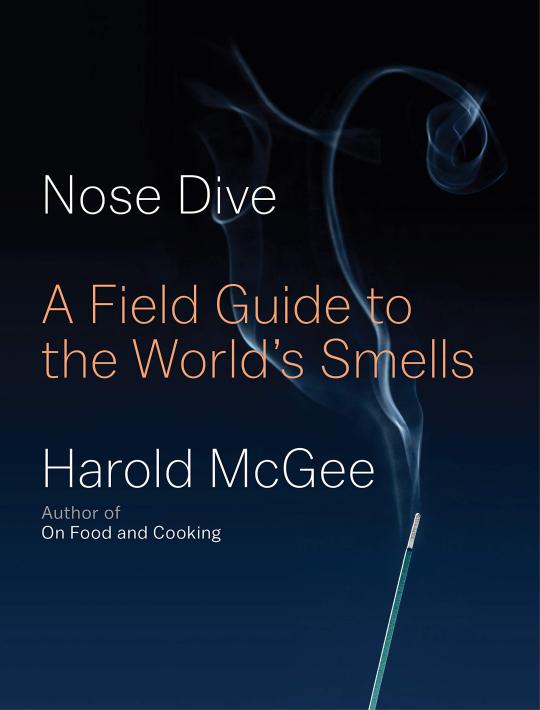
117. Nose Dive: A Field Guide to the World’s Smells by Harold McGee. McGee is a food author, which makes sense. This book profiles the organic chemistry of volatile compounds in their guise as scents, grouped into broad categories and following the journeys of “Hero Carbon” through the land, sea, sky and living things. The book is filled to the brim with interesting connections between the molecules produced by different things, and is a surprisingly deep dive into the world of the microbiome (as many volatiles are made through bacterial and fungal digestion, not by animals themselves). Each of the things it talks about has “tasting notes” of different scent molecules and their aspects. This might be a fun book to have on hand while engaging in a wine tasting or dinner party (remember those?)
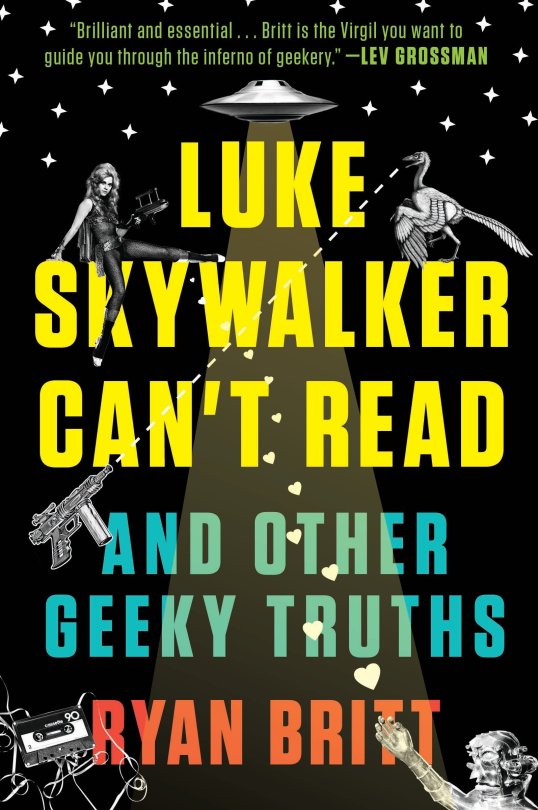
118. Luke Skywalker Can’t Read and Other Geeky Truths by Ryan Britt. Another book recommended to me by library algorithms, this is a collection of essays about pop culture nerd topics. Most of them don’t really have a thesis, just sort of a general “let me tell you about a thing I like” vibe. The title essay, about why the Star Wars universe sucks because of pervasive illiteracy, is one of the better ones, as is the mirror image later in the book about how Star Trek, even most bad Star Trek, incorporates literary themes. The author has a few good zingers sprinkled throughout that I enjoyed, but also makes enough glaringly obvious factual errors (in a nerd book! gasp!) that I suspect that he’s trolling the reader. Also, it’s a glaring act of hubris to include the word “truths” in the title of your book of opinions. Overall, it was fine, but I’m probably never going to think about it again.
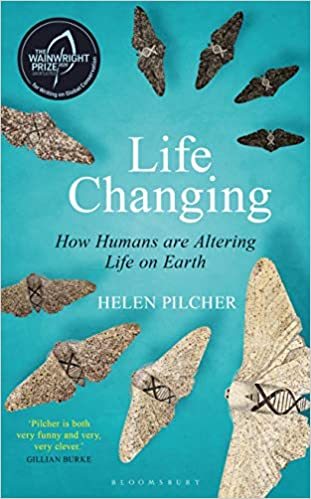
119. Life Changing by Helen Pilcher. After being pleased with Death by Shakespeare, I went on a binge of the Bloomsbury Sigma catalog, which my local library has seemingly all of. This is one of their books from this year, about human directed evolution, both intentional (domestication and genetic engineering) and unintentional (humans as a selective pressure on environments). The writing style is pleasant, and the book wanders down quite a few garden paths, making it a highly enjoyable read and purveyor of trivia. Did you know that Argentina’s premier polo player keeps a stable of cloned ponies, and has been known to switch between clones during matches? Did you know that the inventor of Sea Monkeys was a violent white supremacist? Did you know that about 65 billion chickens are killed for food every year? The whole book is filled with tidbits like this, and ends with a discussion of conservation and a plea for rewilding—not necessarily the dramatic examples like introducing elephants to Europe, but just letting large animals like cows and pigs behave like animals instead of commodities, and the positive impact that can have on biodiversity.
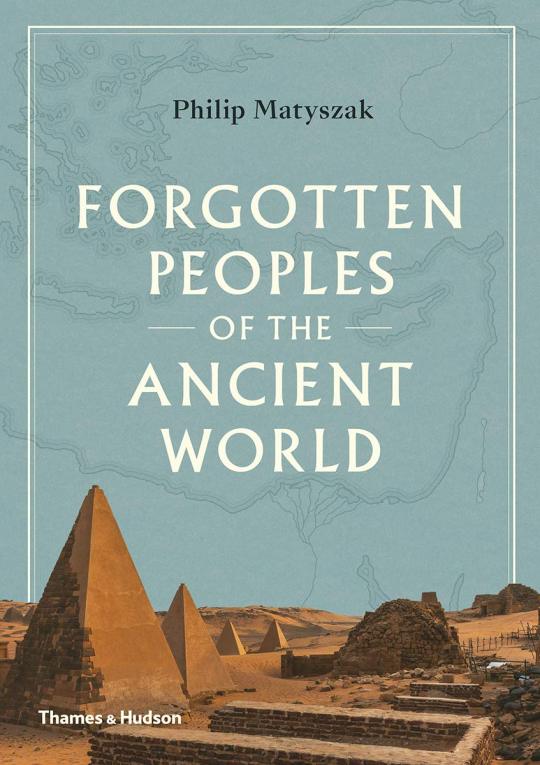
120. Forgotten Peoples of the Ancient World by Philip Matyszak. I always forget how much I enjoy archaeology and anthropology until I read some. This book is filled with brief articles about cultures in the history of the Levant and Mediterranean that have less name recognition than your Assyrians, Egyptians, Greeks or Romans. Some of these are peoples mentioned in the Bible but forgotten outside of their influence on histories or parables, like the Chaldeans, Philistines and Samaritans. Others are those that are more famous for their namesakes than their actual cultures, like the Vandals or Phrygians. Some are people I’d never heard of before. The book has a subtle, wry humor to it, and begins and ends with a reminder that all civilizations are temporary and our perspective is inherently a biased one. After all, Sargon of Akkadia thought his empire spanned the four corners of the world, and he would be remembered forever.
20 notes
·
View notes
Link
The world was running out of time, and so was Joanne Chory.
The 63-year-old biologist was nearing the end of a distinguished career researching how plants grow. Now she’d won the most prestigious honor in her field, the Breakthrough Foundation’s life sciences prize, which came with a $3 million check and an opportunity to address inventors and well-heeled donors at a glitzy Silicon Valley awards ceremony in December 2017.
About this seriesClimate Visionaries highlights brilliant people around the world who are working to find climate solutions.
The audience expected Chory to reflect on her achievements. Instead, she seized the chance to issue a warning.
Human-caused climate change was putting humanity’s future in peril, she said in recorded remarks. Survival would depend Earth’s original carbon-capture machines, the most effective tools for getting rid of greenhouse gases.
People needed to find new ways to grow plants — and soon.
The scientist’s urgency came not only from what was happening around her — record heat waves, catastrophic wildfires and deadly floods linked to climate change — but from the fight within her. Chory had been living with Parkinson’s disease for more than a decade, and the illness was getting worse. The cells in her brain were degenerating, her muscles were in revolt.
With the world teetering toward disaster, she decided, there was only one thing she wanted to do with the days she had left.
In the Breakthrough Prize video, Chory laid out a vision for a new kind of agriculture. She wanted to create “ideal plants” — crops like wheat or rice that are bred to store huge amounts of carbon in their roots. If enough farmers replanted their fields with these engineered species, she said, they could pull as much as 20 percent of the carbon dioxide emitted by humans out of the atmosphere each year.
In time, that speech would get the attention of foundations and pull in millions of dollars in funding, enabling Chory and her colleagues at the Salk Institute for Biological Studies in La Jolla, Calif., to expand their lab and enhance their experiments. They would identify the genes that make plant roots deep and thick and rich in sugar. Their greenhouses and growth chambers would be crowded with seedlings, and their project would be heralded as a revolutionary solution to the biggest problem on the planet.
But on the day she gave her speech, Chory had only her faith that the idea was possible — and her conviction that it had to be done.
“We’re going to make plants better,” she said, her lips twitching into a smile. “And we’re going to end up saving the world.”
Growing in the dark
To hear Chory describe it, photosynthesis is an everyday miracle. Powered by nothing more than sunshine, it converts water and carbon dioxide into flower petals and tree trunks, wide green leaves and spindly stems. Almost all life on Earth owes its existence to this process.
Photosynthesis also shields humanity from the worst consequences of our own actions. Each year, plants take up about a quarter of the planet-warming gases people emit. Put another way: without plants, climate change — which has already disrupted ecosystems and destroyed lives — would be even worse.
“Plants are pretty cool. They’re like a silent partner in all of this,” Chory said. “But nobody ever pays attention to them.”
Chory can empathize; she too overlooked plants for many years. Growing up near Boston in the 1950s and ’60s, one of six children in a boisterous Lebanese American family, she spent most of her time tussling with her siblings or disappearing into novels. She was ambivalent about science until a college genetics course caught her interest, and throughout her graduate studies she was focused on bacteria, not plants.
After receiving her PhD, Chory decided to join a lab that experimented with a tiny weed called Arabidopsis mainly because it seemed less competitive than researching microbes or fruit flies. With so few other scientists studying it, “I thought I could really make a difference there,” she recalled.
For one of her first experiments, Chory wanted to identify a genetic mutation that caused some Arabidopsis plants to be purple instead of green. She stuck some of the seedlings in a dark chamber, just to see what would happen.
Logic dictated that the plants would wither soon after sprouting, deprived of the light that’s needed to power photosynthesis. But several of the seedlings defied expectations, sending out fat shoots and broad, white leaves.
“Most people would say, ‘that’s strange, I didn’t get the mutant I want,’ and move on,” said Fred Ausubel, a Harvard Medical School geneticist who ran the lab where Chory was working at the time. “But Joanne realized immediately she’d found something much more interesting and important” — a mutation that caused plants to thwart their own biology and grow in the dark.
Though the initial discovery was a fluke, it launched Chory into decades of intensive study. Her first major academic paper revealed the gene that switches on a plant’s “growth mode” in response to sunshine. Next she identified hormones that dictate plants’ shapes and sizes. Her discoveries paved the way for research that would improve farmers’ yields and make crops more resilient.
The scientific establishment initially was resistant to the findings — and to the dynamic woman who delivered them. Older researchers would question her analyses. Male classmates and colleagues would try to intimidate her with pranks.
But Chory had inherited determination from her mother, who had dropped out of high school to go to work during the Great Depression, and resilience from her father, who labored long hours as an accountant so the family could make ends meet. She got her thick skin from her siblings, who she lovingly claims “were meaner than anyone I ever met in the lab.”
Eventually, Chory became a plant research superstar. She established her own lab at the Salk Institute, was elected to the National Academy of Sciences. Her published research was taught in college biology classes, where it awed aspiring scientists like Jennifer Nemhauser, who dreamed of studying in Chory’s lab.
“It was so obvious that she was an incredibly original thinker and someone who is very brave — to do things that other people would consider too hard, too weird, too ambitious,” Nemhauser said.
When she came to work with Chory as a postdoctoral fellow in 2000, Nemhauser was ready to be impressed by the older woman’s ferocious intellect. She didn’t expect Chory to be compassionate, witty and wise, with a self-deprecating sense of humor and a willingness to hear out any idea.
“It was the most heady scientific environment I’ve ever been in,” said Nemhauser, now a professor at the University of Washington. Chory’s lab meetings often turned into freewheeling discussions and vigorous debates. The conversations would end with everyone grinning and drenched in sweat.
In 2004, Chory summoned her team to a more sober gathering. She had been diagnosed with Parkinson’s, a degenerative brain disorder that can cause tremors, mobility problems and severe pain, among other symptoms. Though the disease can be treated, there is no cure.
Nemhauser recalled the stricken scene that filled the lab after the announcement. Chory was only 49. She had two young children. It didn’t seem fair that such an accomplished and beloved person would have to deal with so much pain.
Almost everyone in the room was in tears, Nemhauser said. But Chory’s eyes stayed dry.
An idea takes root
For almost a decade, Chory was able to manage her Parkinson’s with medication. But the disease is progressive; by 2014, her symptoms had become severe. Some days, she woke up feeling like her body had aged 40 years overnight. The simple act of walking, she said, was as mentally exhausting as driving in the left lane on English roads.
Chory kept on top of the scientific literature and represented patients at neuroscience conferences. She tried to stay ahead of her disease.
“But the wild swings, and not knowing what you’re waking up to, it can make you kind of anxious,” she said. “I’d rather not think about it.”
So she worked. Between 2005 and 2015, Chory contributed to 117 publications in academic journals: They included titles such as: “Organelle signaling: how stressed chloroplasts communicate with the nucleus” and “A toggle switch in plant nitrate uptake.”
But the rapid escalation of the climate crisis was starting to match the urgency Chory felt about her own health. In 2011, a drought in East Africa caused tens of thousands of people to die of hunger. The following year, Hurricane Sandy ravaged the East Coast. By the end of 2013, the concentration of carbon dioxide in the atmosphere crossed the milestone level of 400 parts per million. And 2014 was the planet’s warmest year on record — until 2016 surpassed it.
There had to be something they could do, Chory would say during those freewheeling conversations in the lab. If human carbon dioxide emissions were the problem, couldn’t plants be part of the solution? After all, plants had been perfecting the art of pulling carbon from the atmosphere for more than 3 billion years.
Around that time, Elizabeth Blackburn, then the Salk Institute president, issued a challenge to the faculty: Do something bigger than your lab. Team up on a project that could change the world.
The institute’s plant biology researchers put their heads together, and the Harnessing Plants Initiative was born.
Some of Chory’s colleagues were surprised by her sudden shift in focus. But not Jack Bolado, who has been her lab manager for more than a decade.
“She is using everything that she’s accomplished to do something focused on the biggest problem out there,” he said. “One last hurrah of her career.”
The initiative’s first challenge was finding a way to make plants better at storing carbon long term. Though the world’s greenery takes trillions of pounds of carbon dioxide out of the atmosphere each year, much of it goes right back to the air when the plants die and their tissue is broken down by microbes.
Wolfgang Busch, a root expert, suggested that plants could be genetically manipulated to put more carbon in their underground parts. This way, their decomposing tissue would be incorporated into the earth, rather than being released into the air. Carbon and other nutrients would be restored to soil depleted by decades of intensive agriculture. And, as an added bonus, deep-rooted plants would be more resistant to flooding and drought.
Next, Joe Noel called the team’s attention to a molecule called suberin, which forms the main component of cork. Each molecule contains dozens of carbon atoms, and the substance is difficult for microbes to break down. If the scientists could get plants to store carbon in this form, it would stay trapped for at least a century — buying time for civilization to shift away from fossil fuels.
The team took multiple approaches to identify the genes they would need to target. In some cases they scrutinized the scientific literature and compared hundreds of wild strains of Arabidopsis in search of desired properties. Then they used gene editing tools to temper or enhance those traits. Another tactic involved soaking Arabidopsis seeds in a chemical that alters DNA, then monitoring how they grew.
In both cases, the researchers looked for plants with the most intriguing qualities. If a sprout was deficient in suberin, that meant a gene related to its production had been knocked out. If another boasted extra thick roots, it also had a mutation worth looking into.
Plants with the right genes could then be crossbred with crops to create the “ideal plant." It would have big, deep roots. It would contain lots and lots of suberin. And it would be able to feed the world.
It wouldn’t be hard to find space to grow this plant: half the world’s habitable land is already devoted to agriculture, which is currently responsible for almost a quarter of global greenhouse gas emissions.
The problem was money. Plant biology has never been a well-funded field of research. But for an experimental program to cultivate a climate-saving plant, there truly was nothing: No National Science Foundation grants. No Department of Agriculture awards. The team applied to all the traditional funding sources and was turned away by every one.
Until Chory gave her speech.
That was a “key moment,” said Busch, who co-leads the Harnessing Plants Initiative. “She used that stage and highlighted not only the work of plant scientists but … this idea of fighting climate change with plant genetics.
“In a way, that set off this sequence of fortunate events that made us successful.”
Shortly afterward, someone suggested that Chory apply to the TED Audacious Project, a collaboration of foundations and philanthropists seeking to fund solutions to the world’s major problems. The program gave Salk $35 million — several orders of magnitude more than the average NSF grant. Then came $30 million from the Bezos Earth Fund (Jeff Bezos of Amazon owns The Washington Post). And millions more from companies such as Sempra Energy and Hess.
“Now we just have to do it,” Chory said. “Doing it is what keeps me up at night.”
The ideal plant
By 2030, scientists say, humanity must cut greenhouse gas emissions almost in half to avoid the most catastrophic consequences of climate change.
“That’s a pretty aggressive timetable,” Chory said. “The question of if it can be done by then is looming large over Wolfgang and me.”
At the start of the decade, the Harnessing Plants Initiative faculty members charted a course they thought would get them where they needed to go. They would spend five years on basic discovery research: Identifying relevant genes in Arabidopsis and crop plant seedlings; using genetic editing techniques or traditional breeding to cultivate those genes in the appropriate crops; conducting small field experiments to see how the plants grow outdoors.
After that they’d have five years for conducting large field trials, scaling up production, and persuading business and politicians to get on board. By 2030, they hoped, ideal crops would occupy half a million acres. By 2035, the plants would sequester 4 to 8 gigatons of carbon dioxide each year — between 10 and 20 percent of humanity’s current annual emissions.
But then the coronavirus pandemic consumed the country and shuttered their lab. Two generations of experimental plants were lost. Still more troubling, Chory says, is the loss of momentum.
“I have to keep cheering people up,” she said.
When Chory finds herself struggling to stay positive, she imagines the future that awaits if people don’t address climate change: Catastrophic fires and devastating floods. Widespread food and water shortages. Destruction of habitats and extinctions of species at a rate not seen in millions of years. “Do you really want your kids to see that?” she asks herself.
And then she envisions the future she still believes is possible: People living in smaller, safer, more sustainable houses. Windmills churning and solar panels gleaming from mountainsides and fields. She pictures acre after acre of farmland planted with engineered crops, their roots reaching deep into rich, healthy soil. She thinks of carbon dioxide concentrations ticking downward — measurable, meaningful change.
Chory’s uncertain health means her own future is a mystery. But she can envision her children, in their 30s, on a planet that is thriving.
“I would like for my kids to be thinking,” she said, “that I did something important for their world.”
3 notes
·
View notes
Photo
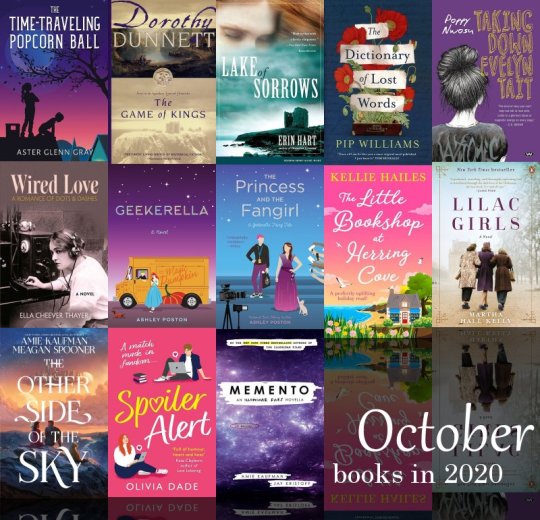
Books read in October
I read a paperback book for the first time in over three months months and was sharply aware that I couldn’t change anything about the way the text was displayed to make it more comfortable to read. I wondered, sadly, if I no longer like reading physical books.
Then I became engrossed in the story, and there were long stretches of time when I didn’t think about how I was reading a brick of printed paper. I turned pages as automatically and effortlessly as breathing. I think I was just out of practice.
This month’s Unintentional Colour Scheme: pink, purple and light blue.
Favourite covers: The Time-Traveling Popcorn Ball and The Other Side of the Sky.
Also read: “Good Neighbors” by Stephanie Burgis and Tiny House, Big Love by Olivia Dade. (And half a romance novel which I disliked and have no interest in remembering or reviewing.)
Reread: The last section of The Beckoning Hills by Ruth Elwin Harris. The middle section of Hunting by Andrea K. Höst.
Still reading: Between Silk and Cyanide by Leo Marks, and Angel Mage by Garth Nix.
Next up: The Switch by Beth O’Leary, and Hamster Princess: Little Red Rodent Hood by Ursula Vernon.
*
The Time-Traveling Popcorn Ball by Aster Glenn Gray: A magical story of time-travel and of friendship between eleven year old Piper, who has just moved into a new house, and Rosie, who lived in the same house fifty years earlier. It’s totally charming, and exactly the sort of story I adored growing up. Sometimes that makes me wish I could send a book back in time to my younger self, but I appreciated this book’s references to things that my younger self didn’t know about. I also appreciated how, even though I’ve read similar stories, I couldn’t predict how this one would end. That was very satisfying.
The Game of Kings by Dorothy Dunnett: In 1547, Francis Crawford, the Master of Lymond, wanted by the Scottish government for treason, is back in Edinburgh. The audiobook was the perfect way to experience this! The voices the narrator uses highlights clues in the text, about who’s speaking or the subtext and emotional tones of a conversation, which helped me to follow the story even when I felt confused about exactly what was going on. I enjoyed the Scottish accents, the clever wit, the ambiguity about Lymond’s plans and motives, and the way many characters are very intelligent, perceptive people. I was interested in the historical political intrigue. I loved the twists and revelations, which are brilliant -- incredibly clever and satisfying.
“Good Neighbors” by Stephanie Burgis: The first “fantasy rom-com” about a grumpy inventor who, along with her father, moves into a cottage nextdoor to a notorious necromancer in his big black castle. I wasn’t expecting to read about Mia stitching up undead minions, but appreciate that Burgis doesn’t take this opportunity to give glory details. This short story was fun and satisfying, and I am looking forward to when the rest of this series becomes (easily) available.
Lake of Sorrows by Erin Hart: After Haunted Ground, Dr Nora Gavin heads to the midlands west of Dublin to oversee the evacuation of another body discovered in a peat bog. The setting is fascinating and I like the atmosphere -- this has a strong sense of both place and mystery. However the multiple murders meant there’s more unpleasantness than I’d prefer. But it’s probably not enough to deter me from reading the next book.
The Dictionary of Lost Words by Pip Williams: Engrossing -- a poignant story of childhood during the late 19th century and womanhood in the early 20th century, and an absolutely fascinating insight into the decades-long process behind the first Oxford English Dictionary. Esme’s father is one of the lexicographers collecting and defining words for the Dictionary. Esme grows up with a fascination for words and begins to collect words that the Dictionary leaves out. I liked that Esme has people in her life who love and support her, but the ending is intensely sad. I’m not sure why that disappointed me. As an ending, it fits this story.
Taking Down Evelyn Tait by Poppy Nwosu: Australian YA. Lottie is furious that no one else seems to realise what Evelyn Tait, her nemesis (and stepsister) is like. Her best friend Grace is in love with Evelyn. Her teachers and her father tell Lottie she should emulate Evelyn. So Lottie decides that she’s going to do just that -- she’s going to be better than Miss Perfect. I thought this was a very realistic portrayal of a teenager’s relationships -- with family, with friends, with school and with herself. It’s amusing and, ultimately, believably positive. It captures Lottie’s perspective and her experiences in-the-moment so effectively and intensely.
Wired Love: a romance of dots and dashes by Ella Cheever Thayer (1888): Nattie, a telegraph operator who chats whenever she can “over the wire” with C., another telegraph operator miles down the line. I love stories where characters fall in love through exchanged messages. And the experiences of telegraph operators is absolutely fascinating -- simultaneously a product of the past and yet incredibly relatable from a contemporary perspective, because the internet and mobile phones mean we communicate so much through text. After Nattie and Clem meet, the focus shifts away from the telegraph office to antics at their boardinghouse, but the story continues to be fun and delightful.
Once Upon a Con series by Ashley Poston:
Geekerella: When Elle discovers her late parents’ cosplay costumes in a box in the attic, she hatches a plan to enter a cosplay competition and use the prize to escape her step-family. This contemporary Cinderella retelling about two teenage fans of a SF series Starfield is a romance-through-messages story. Elle uses her father’s old phone, so sometimes she gets messages from people about ExcelsiCon, the convention her father founded. One message sparks a conversation -- but neither she nor Darien realise just who they’re texting. As expected, this is fun and fandom-y, and it makes the coincidences and Cinderella moments feel believable.
The Princess and the Fangirl: At ExcelsiCon, Starfield actress Jessica Stone swaps places with a fan, Imogen. Jess needs to find a mislaid script before she’s accused of leaking it, and Imogen hopes for an opportunity to promote the #Save Amara initiative. I enjoyed how they both experience a different side of fandom. Imogen discovers the pressures of being a star, when con appearances are your job, and, away from the spotlight, Jess discovers how cons allow people to come together and celebrate things they love. My only disappointment was the way they both deceive Imogen’s fandom friend, Harper. I wish that had been handled differently.
The Little Bookshop at Herring Cove by Kellie Hailes: Unlike other books I’ve borrowed because they had “bookshop” in the title, this didn’t focus very much on books, nor did it describe its bookshop vividly. Sophie could have easily owned a different sort of shop without changing the plot, the setting or the atmosphere. This is a light-hearted romance about nice people in a generic seaside town -- not what I was looking for. I wanted more about books and a stronger sense of place.
Lilac Girls by Martha Hall Kelly (narrated by Cassandra Campbell, Kathleen Gati and Kathrin Kana): This begins with three different women at the start of WWII -- a teenager in Poland, a newly-graduated doctor in Germany and a wealthy consulate worker in New York -- and becomes about the Ravensbruck Rabbits, Polish political prisoners subjected to medical experimentation. Not what I expected or wanted to be reading (which is not its fault. I switched to the ebook, because I'm irrationally squeamish about some medical things and cope better when reading to myself). This story is compelling and does a good job of showing how the pain and trauma didn’t just end with the war. And it’s incredibly important to keep telling stories about distressing parts of history.
The Other Side of the Sky by Amie Kaufman and Meagan Spooner: More or less the sort of story I expected from these two. Nimh is the Divine One in a world of magic and prophecy. North is a prince in a floating city of science and engineering. Nimh believes the gods fled into the sky thousands of years ago, and North believes no one still lives down on the surface… until he crashes his glider. I enjoyed this but don’t feel any emotional investment -- yet. I will read the sequel.
Spoiler Alert by Olivia Dade: April and Marcus keep fandom separate from their professional lives -- April to avoid negative comments, Marcus (an actor) to avoid violating his contract. So when Marcus sees a cosplay photo of April online, he doesn’t recognise his friend, he just sees a gorgeous woman getting nasty comments and invites her to dinner. I was hooked. As a romance, this didn’t always focus on the things I most wanted it to, but I understood why it made those narrative choices and liked how the characters resolved their mistakes. And I really liked it as a story about fanfiction and the way we tell stories in response to other stories.
Big Love, Tiny House by Olivia Dade: Lucy goes on a Tiny House Hunting show and drags along her best friend Sebastian. I’ve watched countless tiny house videos on Youtube, so it was fun to see tiny houses depicted in fiction -- although I was disappointed that all the houses are so disastrously bad. Beyond that, I have no strong feelings one way or another about this romance novella.
Memento: an Illuminae Files novella by Amie Kaufman and Jay Kristoff (narrated by a full cast): A bonus prequel, set aboard the Alexander prior to the events of Illuminae. The audiobook is so well done! Even though this is a short story/novella, I cared about the new characters it introduces -- I really like the epistolary format and how it requires the reader to fill in some of the gaps for themselves. (I think that’s part of why I love The Illuminae Files but so far have no strong feelings about Kaufman and Kristoff’s latest series.) And it’s always interesting to see more of AIDAN.
#Herenya reviews books#Aster Glenn Gray#Dorothy Dunnett#Erin Hart#Pip Williams#Poppy Nwosu#Ella Cheever Thayer#Ashley Poston#Martha Hall Kelly#Amie Kaufman#Meagan Spooner#Jay Kristoff#Olivia Dade#Stephanie Burgis
9 notes
·
View notes
Text
Art and the Environment
“Part of addressing a complex politics of ecology and its aesthetic reach means critically rethinking current or provincialist terms of debate by foregrounding overlooked actors, actants, voices and constituencies. In examining social, political and environmental conditions of crisis, envisaging a post-humanist method of inquiry towards the long-term development of sustainable solutions does call for the rejection of binaries or polarisations. Yet it must also be pursued on a cross-disciplinary basis that aims to animate serious proposals that reject and rethink the ‘restricted economy’.”
Carolina Caycedo
BE DAMMED (ongoing Project)
In Indigenous cosmogonies of the Americas, all bodies of waters are connected. Rivers are the veins of the planet, their waters associate communities and ecosystems. Be Dammed investigates the effects that large dams have on natural and social landscapes in several American bio-regions. More than 250 large hydroelectric dams are projected or under construction by transnational corporations in Latin America, signifying the transition of public bodies of water into privatized resources. At the same time, the U.S. is the leading country in dam removal, allowing for the restoration of river ecosystems. In Be Dammed, aerial and satellite imagery, geo-choreographies and audio-visual essays intersect social bodies with bodies of water, exploring public space in rural contexts, and conjuring water as a common good.
Conjuro de rios - rio cauca e hidroituango dam
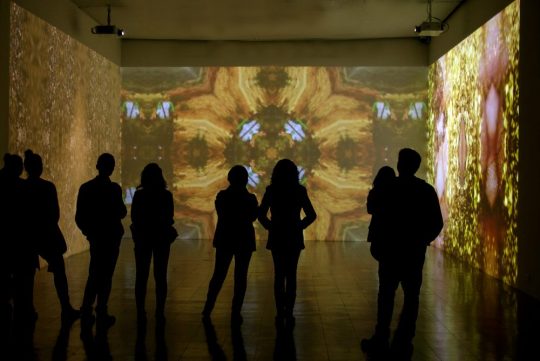
Itaipu river

The Cosmotarrayas
a series of hanging sculptures assembled with handmade fishing nets and other objects, collected during my field research in different riverine communities affected by the privatization of waters in Colombia and Brazil.
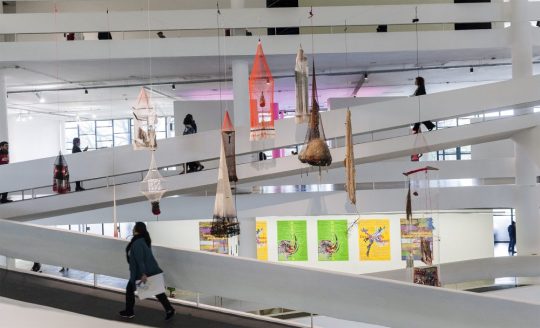

YUMA, or the land of friends, El Quimbo Dam
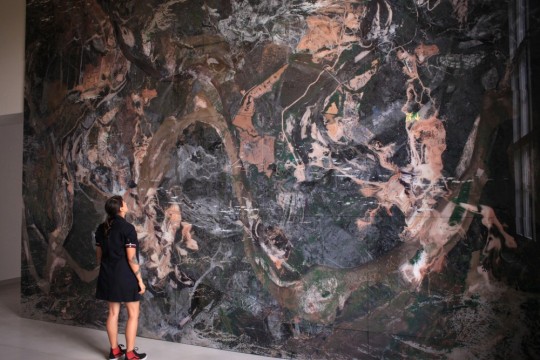
Lygia Clark
Baba Antropofágica
In collective works like «Túnel» or «Objetos relacionais,» Lygia Clark initiates psychic processes of exchange which transform the dichotomy of subject and object. In doing so, she follows the transgressive logic of «devouring» and «vomiting». The reception of «Baba antropofágica» («Cannibalistic Saliva») also relies on the documentary film «O mundo de Lygia Clark,» filmed by Eduardo Clark in 1973. But escaping this phantasmal staging of the body seems almost impossible: kneeling over a guinea-pig-like subject lying on the floor, a figure pulls from its mouth—like spiders do from their bodies—a spittle-drenched thread and spins a cocoon around the reclining figure. The precarious division of subject and object is eliminated by this thread-like weaving, with the gestural webbing of the passive subject completing the inversion of the internal and external. In the retrospective, these interactive aspects might have been what was most convincing. In contrast to Performance and Body Art, Lygia Clark understood herself to be an initiator of processes, and was most successful in this respect when her haptic attempts on orderings were targeted at inter-subjective body politics.


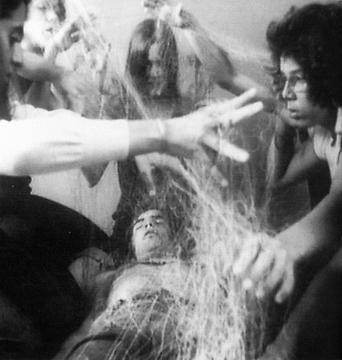
“¿Cuál es entonces la misión del artista?”, decía Clark, “Dar al participante el objeto que no tiene importancia por sí mismo y que sólo la tendrá en la medida en que el participante actúe. Es como un huevo que sólo revela su interior al ser abierto. (…) Es menester que la obra no cuente por ella misma y que sea un simple trampolín para la libertad del espectador-autor. Éste tomará conciencia a través de la proposición que le es ofrecida por el artista. No se trata de la participación por la participación, ni de la agresión por la agresión, sino de que el participante dé un significado a su gesto y de que su acto sea alimentado por un pensamiento, en ese caso el énfasis de su libertad de acción.” (1997: 152-153)
re-enactment
Short film records "Anthropophagic Slobber", proposal by Lygia Clark (1920 - 1988) (re)lived at Clark Art Center (CAC), Rio de Janeiro, Brasil, with Jards Macalé. Direction and screenplay: Walmor Pamplona. By Clark Art Center.
vimeo
she termed relational objects (everyday objects that the artist employed in an attempt used to stimulate the senses)
“Toward the end of her career, Clark coined another term, phantasmagoria of the body, which was also a way of intertwining art and psychotherapy. It’s a practice that deals with the notion of a life within an art object, something that scholars usually dismiss. It was through the discovery of her concept of the “phantasm” that Clark was able to surpass a mere anticipation of sensorial knowledge to enter the realm of actual fulfillment of that knowledge—a concept that differs from the contemporary notion of performance, and moves into the unconscious.
(...)
In Anthropophagic Slobber (1973) the ritualistic aspect of the proposition is crystal clear: a person lies on the floor, arms against her body. She doesn’t wear much. She rests, her eyes are closed. A group of people approach, they come, they kneel. They form a circle around the lying person and put colored threads inside their mouths—the threads are expelled from their lips wet, soaked with slobber. Saliva is stimulation. These people are then like spiders, depositing the webs on the person’s body. The spider can see the prone body—but only her “phantasm” can see the spider. It is within this kind of exercise that the object, a simple thread, becomes, for Clark, a powerful tool for the marriage between body and unconscious knowledge through art. When the person allows herself to become part of this embracing web, the slobber accepts her, she accepts herself.“ (from: https://artwriting.sva.edu/journal/post/lygia-clark-at-moma)
Vogue Germany January 2020
Images of a editorial photo shoot of the Voque Germany of January 2020, inviting artist Katharina Grosse as art director for the editorial fashion part. It’s called : Imagine (our title). She invited a platform of women ‘ Wir machen das’, writers, artists, architects, students, musicians to join the project. Their working field is migration, diversity and refugee movements in conversation with and over ….. The shoot shows divers types of women of different ages and shapes together in a shoot having conversations, also exposed in writings in the magazine.
https://wirmachendas.jetzt/en/mission/
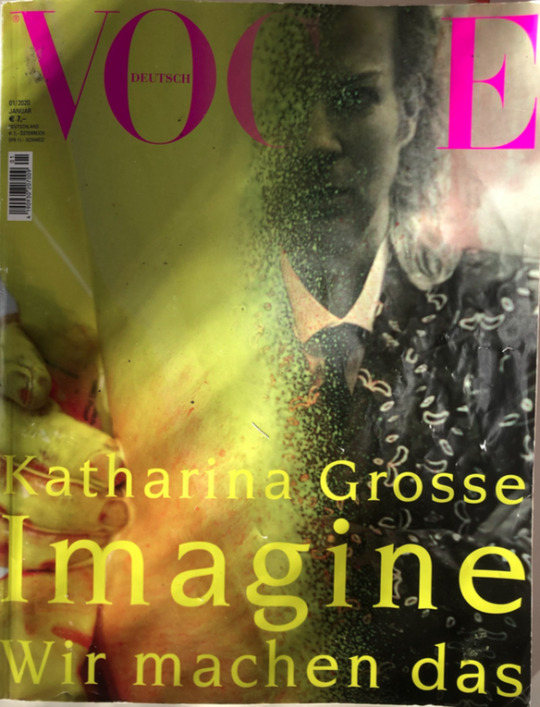
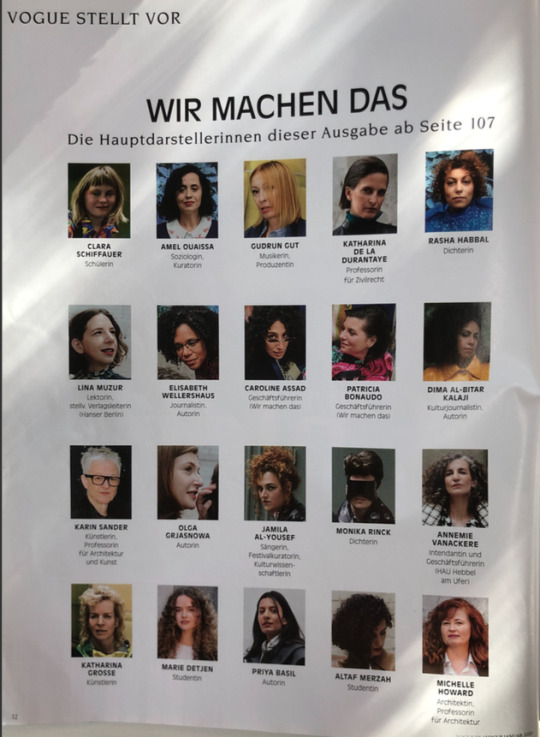
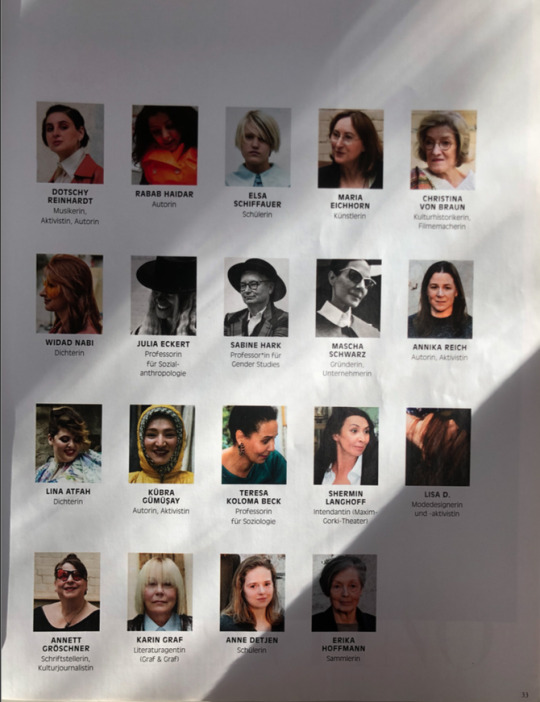
WIR MACHEN DAS – and this is who we are
WIR MACHEN DAS (WE ARE DOING IT) arose from a network of 100 women from arts and culture, science, journalism and public life under the association wearedoingit e.V. in 2015.
As a non-profit organisation we use various projects in the fields of arts and public relations to advocate for support, participation and the recognition of diversity in the context of refugee movements and migration.
Our Aims
We address all people not as “the needy”, but with regard to their expertise, because diverse perspectives enrich local discourses. Together we aim to improve career prospects, educational offers and networking opportunities. We foster individual resources and create opportunities for exchange. In this way, we bolster the involvement of people from zones of war and conflict. Together we are shaping a future in which immigration and diversity are seen as an opportunity and asset.
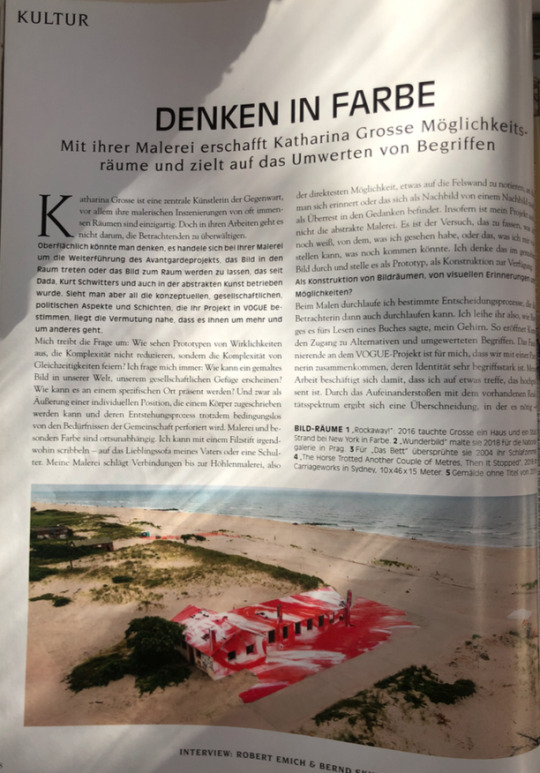

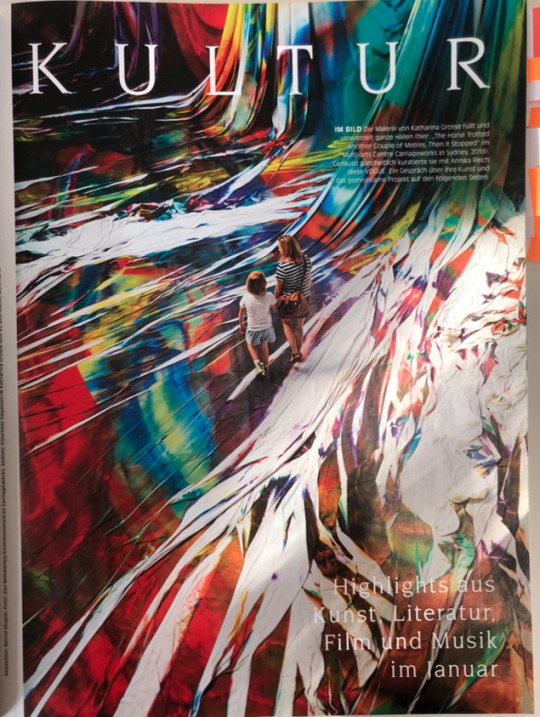
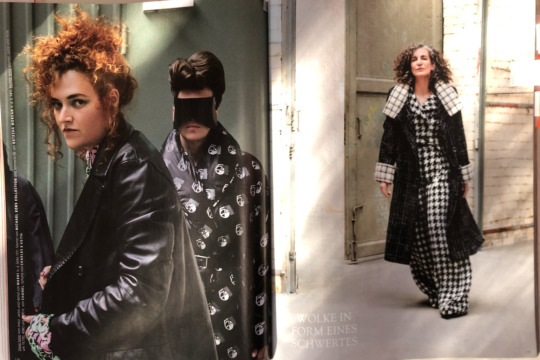
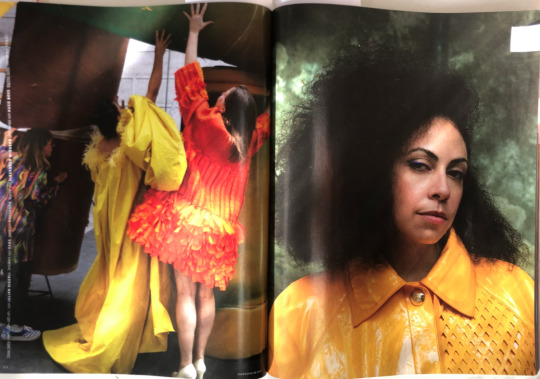
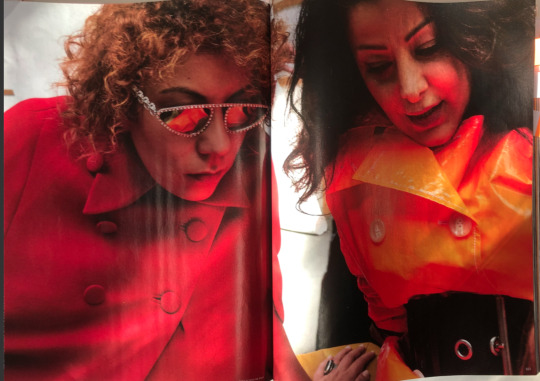



Plastic T-shirt bag invented to save the chopping of trees for paper bags in 1960
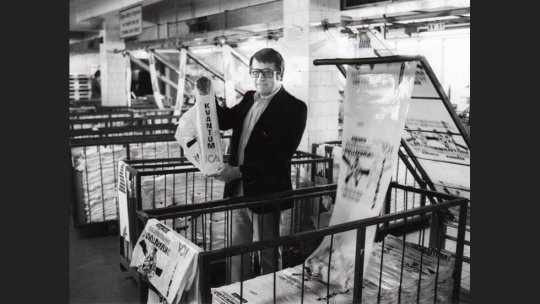
The inventor of the plastic bag Sten Gustaf Thulin. He intended the opposite with his invention:
American and European patent applications relating to the production of plastic shopping bags can be found dating back to the early 1950s, but these refer to composite constructions with handles fixed to the bag in a secondary manufacturing process. The modern lightweight shopping bag is the invention of Swedish engineer Sten Gustaf Thulin.[1] In the early 1960s, Thulin developed a method of forming a simple one-piece bag by folding, welding and die-cutting a flat tube of plastic for the packaging company Celloplast of Norrköping, Sweden. Thulin's design produced a simple, strong bag with a high load-carrying capacity, and was patented worldwide by Celloplast in 1965. As his son Raoul said later, Sten believed that durable plastic bags will be not single-used but long-term used and could replace paper bags which need chopping of trees.[7][8]
Source: https://en.wikipedia.org/wiki/Plastic_shopping_bag
https://www.independent.co.uk/environment/plastic-bags-pollution-paper-cotton-tote-bags-environment-a9159731.html
https://disposableamerica.org/the-plastic-bag/inventor-sten-gustaf-thulin/
Nzambi Matee

A nairobi-based 29-year-old entrepreneur and inventor — is the founder of a startup that recycles plastic waste into bricks that are stronger than concrete. called gjenge makers ltd, her company initiated following the development of a prototype machine that turns discarded plastic into paving stones. one day at the factory means 1,500 churned plastic pavers, prized not just for the quality, but for how affordable they are.
‘it is absurd that we still have this problem of providing decent shelter – a basic human need,’ said matee. ‘plastic is a material that is misused and misunderstood. the potential is enormous, but its after life can be disastrous.’
before creating gjenge makers ltd, nzambi matee majored in material science and worked as an engineer in kenya’s oil industry. in 2017 she quit her job to start creating and testing pavers, which are a combination of plastic and sand. she gets the waste material for free from packaging factories and also buys it from other recyclers. through experimentation, she understood which plastics bind better together and then created the machinery that would allow her to mass produce them.

‘we must rethink how we manufacture industrial products and deal with them at the end of their useful life,’ said soraya smaoun, who specializes in industrial production techniques with UNEP. ‘nzambi matee’s innovation in the construction sector highlights the economic and environmental opportunities when we move from a linear economy, where products, once used, are discarded, to a circular one, where products and materials continue in the system for as long as possible.’

Pierre Huyghe - Zoodram
Zoodrams: large aquariums with marine ecosystems, that embody the logic of the exhibition, in particular Zoodram 4 (2011) in which a crab turned a resin mask of the Sleeping Muse (1910) by Constantin Brancusi into its living habitat.


Zoodram 5 (After Sleeping Muse by Constantin Brancusi), 2011, a glass tank that provided living quarters for different species of crabs that cannibalize each other, a none-too-subtle metaphor for human rapaciousness.
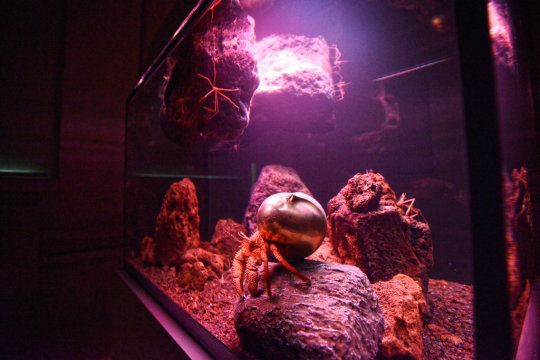
The tank is a repeated object in many of Huyghe’s works. They featured prominently in his retrospective, and a massive fish tank currently sits on the roof of the Metropolitan Museum as part of the Roof Garden Commission. Huyghe’s tanks are filled with strange, beautiful creatures. On the roof of the Met are tadpole shrimp, while inside the tanks in the retrospective were hermit crabs. The tank is an enclosed space. The viewer stands outside it, watching the creatures engage in their everyday activities. The tank is a lens through which we can better see Huyghe’s overall project. In an interview with Emily Nathan for Art in America, Huyghe stated:
The work is not “displayed” under a narrative — that’s a system I avoid. I could not imagine a chronological order, either. As you say, most of what I have done is construct situations that happen within a given body. Every one is a constellation network of process, all sorts of heterogenous and anachronistic things come together or are associated within a constructed situation, and so it is difficult to present them in a site where they were not originally, or to organize them in a linear way.
Pierre Huyghe says that life is the core interest of his practice: “I’m interested in how to quantify the different variations of being alive…how to intensify the presence of things.” Many of his performance, film, and installation pieces employ a range of living creatures—insects, plants, animals, and human beings—in order to explore their behavior and interactions. These works become laboratories for articulating complex social phenomena, the precarious distinction between fiction and reality, and contemporary belief systems.
Pawel Althamer
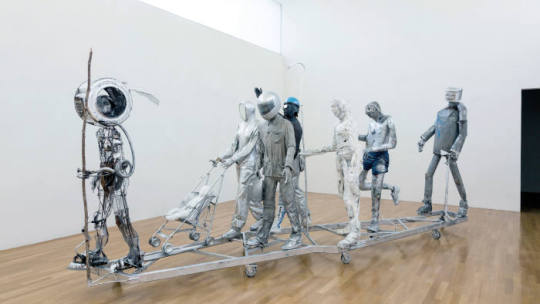
The sculptor Pawel Althamer, who had a cameo in After Nature with a pair of flayed bodies, has brought an entire parade of the undead to Expo 1. He and neighbours from his apartment block in Bródno, Poland, each created a life-sized alter ego, modelled out of scrap metal and technological trash. Like zombies from an apocalyptic nightmare, the figures in “Bródno People” march sightlessly through a huge gallery, an ungainly procession of solid ghosts that recalls Rodin’s “Burghers of Calais”.
Mel Chin
Revival Field

1991-ongoing plants, industrial fencing on a hazardous waste landfill an ongoing project in conjunction with Dr. Rufus Chaney, senior research agronomist, USDA
Revival Field began as a conceptual artwork with the intent to sculpt a site’s ecology. 1993 marked a successful conclusion to the first phase of this collaborative effort. The initial experiment, located at Pig’s Eye Landfill, a State Superfund site in St. Paul, Minnesota, was a replicated field test using special hyperaccumulator plants to extract heavy metals from contaminated soil. Scientific analysis of biomass samples from this field confirmed the potential of “Green Remediation” as an on-site, low-tech alternative to current costly and unsatisfactory remediation methods. Despite soil conditions adverse to metal uptake, a variety of Thlaspi, the test plant with the highest capacity for hyperaccumulation, was found to have significant concentration of cadmium in its leaves and stems.
vimeo
In Mel Chin’s Revival Field FIG. 3 soil is detoxified through the use of ‘hyperaccumulator’ plants in a dumping ground in Minnesota, demonstrating the need for speculative ecological proposals.
Thomas Hirschhorn
Jumbo Spoons and Big Cake



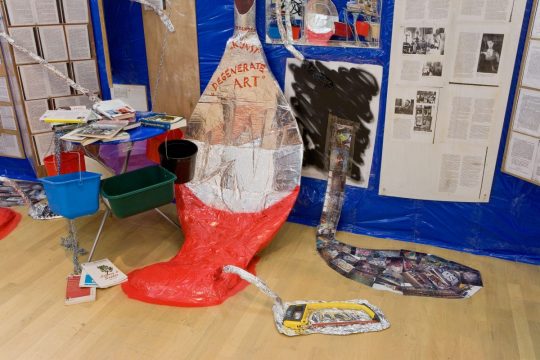
At first glance, Thomas Hirschhorn’s monumental installation Jumbo Spoons and Big Cake resembles a kind of documentation centre turned upside down, filled with papers, chained books, piled archives and photographs. In the centre, the jarring presence of a monumental cake surrounded by twelve giant spoons creates a metaphor on the state of the world today, and on the end of many 20th century utopias. Reminiscent of popular ‘souvenir spoon’ trinkets, the spoons portray individuals or entities that the artist associates with failed utopias: Mies van der Rohe, Rosa Luxemburg, Malevitch, Nietzsche, Venice, China, the Moon, firearms, fashion, the Nazis’ 1937 exhibition of “degenerate art,” Swiss Rolex watches, and the Chicago Bulls basketball team.
Tejal Shah
Between the Waves

Landfill Dance by Tejal Shah FIG. 5 is a video installation that involves several professional dancers dressed as quasi-mythical creatures, striking poses and moving in synchronicity in an unnamed mass landfill site in India. The work portrays ‘neither a neoliberal optimism nor paralysing despair’, but instead draws on the ‘potential of the bodies to coexist with this environment’, as is part of Boetzkes’s broader thesis that artists have demonstrated the need for an ‘intensive “working through” of the site’ and waste (pp.121–25). How, if at all, the work deals with people that notoriously have little choice but to rummage and work through mass garbage sites on a daily basis is unattended to.
Tejal Shah: Landfill Dance is part of the larger five-channel video installation, Between the Waves. Each channel also functions as a stand-alone piece. I first worked on channel 1, which is a longer film that forms the backbone of the installation.
“I am a big fan of contemporary and folk dance, with immense reverence for the medium. I have been eagerly awaiting an appropriate opportunity to collaborate with dancers. Finally, I decided to work with contemporary dance in this project to create seemingly nonsensical movements within the setting of a landfill to think about the futility of our gestures of sense making and recuperation in the Anthropocene (with a sense of humour of course!).” (https://huismarseille.nl/interview-tejal-shah/)
vimeo
vimeo
Olafur Eliasson
“Riverbed was for the Louisiana Museum, whose architecture is from a period where the seamlessness between inside and outside was introduced, as were a number of modern illusions of openness,” he says by way of preface. “Within this very contemplative museum, but also this very well functioning exhibition machine, I wanted something that would almost have the volume and scale to destabilise the museum a bit, pressure it. So I wanted it to look almost like a rock garden, but also to have a sense of a mudslide. Brutal, deathlike; it’s almost an alien landscape, and really it’s there to introduce destabilising qualities that one experiences outside – you’re walking on a slope, keeping your balance, recomposing your walking to fit the landscape – but you don’t really notice, you take them for granted. So I don’t only move the landscape in but also the microconflicts: suddenly we don’t take them for granted. This is what is interesting: the experience, the activities you do, also become exhibited. It’s as much about the interaction as about the actual plateau, the platform, on which people are walking.”



5 notes
·
View notes
Text
[FGO Fan Servant Redux] King Sejong the Great (Genderbent)
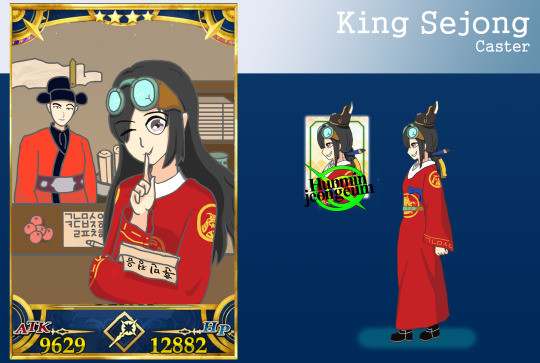
안녕하세요!
This is a remake of last year’s attempt at making a fan Servant, intended for Hangeul Day to celebrate his legacy. (2 days late...) Probably the only Korean with an actual chance of making it into FGO, if DW ever allows that.
Introducing, King Sejong the Great! Genderbent, of course. Because this is Fate, what were you expecting? (I know it’s not completely historical, but it makes for a fun story.)
Name: King Sejong the Great
Class: Caster
Origin: Korea – Joseon Dynasty (1400s)
Alignment: Lawful-Good
Type: Man
Bio: Curiosity. Generosity. Spite. The 4th King of Korea’s Joseon Dynasty.
An insatiable thirst for knowledge, both scientific and magical, and knack for inventing that led to the kingdom’s first royal research institute. An all-giving kindness for her downtrodden people that weakened her status and health. A pure spite for the nobility, inheritance from her father and reinforced by tragedy. She sought to bring meritocracy onto an already stagnant society. Welfare for the poor. Knowledge to all. For in her eyes, all were genuinely equal.
She who utterly shattered the status quo and changed the course of a nation with just one invention, personally handmade by the King herself. Hangeul, a written alphabet for her people that even a peasant could learn in a week. An invention that may have saved them centuries in the future.
She truly earned the title of ‘The Great.’
[Skills, Additional Sprites, and Lore]
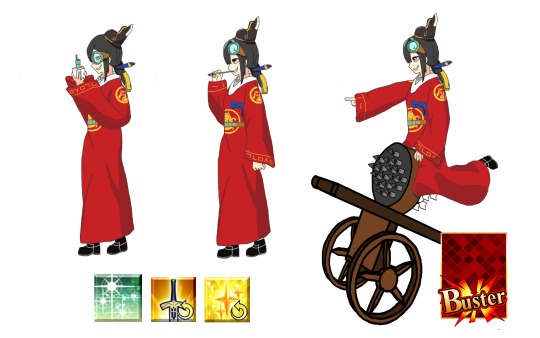
Class Skills
Territory Creation Rank A-: The Hall of Worthies, her kingdom’s first Royal Research Institute, which contained the King’s personal workshop and gave birth to many creations.
Item Creation Rank B: Was personally involved in the creation of Hangeul and many other projects at the Hall of Worthies in the fields of agriculture, astronomy, warfare etc.
Personal Skills
Patronage B: Served as patron to the Hall of Worthies, when she wasn’t busying herself there already. Heavily believed in meritocracy and held the belief that anyone, regardless of status or lineage, could succeed if given the chance. Personally, she handpicked a peasant for the position of Royal Engineer, a true embodiment of her beliefs.
Charisma C: Wildly popular amongst the populous, and able to persuade the fickle Royal Court, regardless of how many times she pissed them off.
Humanitarianism A: Improved literacy nation-wide. Supported paternity leave for both mothers and fathers. Introduced tax reform to reduce burden on famine-stricken areas. Funded many inventions to help improve citizens’ livelihood. She truly loved her people, no matter the costs.
Rapid Words of Casting EX: Invented an entire alphabet for the express purpose of easier and faster reading and writing. Duh?
Entertainment Revision EX: Gains access to skills she does not normally possess. Stronger the more dramatic and flashier the skill is. Similar to Imperial Privilege. (Blame K-Drama.)
Quotes
Edison: Anyone can learn my alphabet in a week. But moving pictures need no introduction. This would have been so useful for so many reasons! Show me more films, Mr Haechi!
Nobunaga: ...For both our sakes, that ‘monkey’ of yours better not show his face to me.
Shakespeare: This is the epitome of western entertainment? Fascinating. You know, I too dabbled in poetry a bit. Perhaps we can share notes?
Touta: The people are the roots of a nation, and those roots should be well-fed so as to create a peaceful nation. That rice bowl of yours is truly beautiful. May I look inside..?
Archer Gil: How could a king who should rule over all people and all things in the country with impartiality treat those of low birth any differently from the way he treats others? I am willing to bow my head towards my people if needed. What say you?
Babbage: ...I want that! To the Hall!
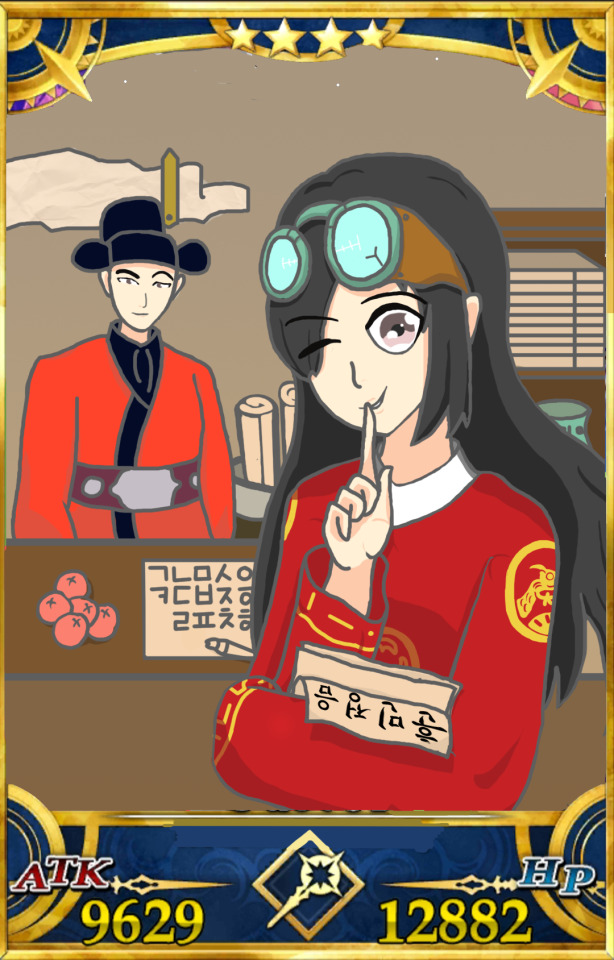
Bond 1: The third child of the third King Taejong (태종), three generations separated from their dynasty’s founder Taejo (태조). Ido was the apple of her father’s eye, her curiosity and (properly timed) rebellious spirit catching his eye, but was initially ignored regarding inheriting the throne. However, her two older brothers abdicated the throne to separate themselves from their father’s bloody legacy of murdering all his relatives and many more to maintain his power. With that, the path was cleared and Ido took to the throne upon her father’s surprisingly peaceful death, taking the name Sejong for herself. Contrast to the previous king’s blood-soaked reign, Sejong devoted herself to her people and to improving quality of life throughout the nation, even establishing the Hall of Worthies to advance the field of agriculture, astronomy, warfare etc. with her patronage and personal participation. She did inherit her father’s dislike for the nobility, and for good reason.
Bond 2: She did not care for social norms and promoted meritocracy, holding the belief that if anyone, regardless of status or bloodline, could accomplish anything if they were giving a chance to prove themselves. Her embodiment of this belief would be Jang Yeong-sil (장영실), a former peasant-turned-Royal Engineer and close confidant. Having heard rumours of his cleverness, she personally invited the son of an escort to the palace, where he managed to impress the King. Excited, she took him under her wing, despite the protests of the nobility. Nevertheless, he would prove himself a worthy ally, helping to create independent advancements in the fields of astronomy and meteorology using his knack for inventing. Bonding over their love of the pursuit of knowledge, he and the King shared a very close friendship, one plagued with hijinks, ‘SCIENCE!’, and ink-soaked robes. Her trust in him was absolute, even willing to forgive him immediately when one of his inventions proved faulty and injured the test subject… who just so happened to be the King herself. Unfortunately, the nobility, jealous of the inventor and fearful for their own positions, seized upon this opportunity, having him tried and imprisoned in spite of the King’s protests.
A betrayal unlike no other. A reminder of the callousness of the Royal Court and of her fragile power.
Bond 3: Noble Phantasm: [훈민정음 – 한글]
The Proper Words for the Instruction of the People.
Rank: EX
King Sejong’s most influential creation. The one that would forever earn her the title of ‘The Great’. Developed in secret at the Hall of Worthies, its very existence alone had the potential to put even a king’s life in danger. Penned by the King personally, it was a scientifically-designed featural alphabet with 17 constants and 11 vowels, created to replace the ill-fitting Chinese characters that had been in use up to this point, in spite of Korea having had a separate spoken language for centuries. Designed for ease of reading and writing, even a peasant could learn in a busy week, an afternoon for a noble. Upon its completion, it was initially announced to the Royal Court, who opposed its very existence. Even those loyal to the crown protested, fearful that a literate populous would prove unruly and rebellious. In spite of, or perhaps because of the protests of the nobility, it was released on October 9, 1495, immediate adopted by the public.
Bond 4: Literacy reached an all-time high. It would kickstart a literary Renaissance that would last for generations, as even the peasants, now literate, could participate, partaking in others’ adventures while sharing their own experiences. Even the nobility, initially disdainful, would later adopt it, both in private and public affairs. But their warnings were right, in a way. An educated populace with ease of communication and plenty of grievances (for future kings) meant many rebellions to come. But it also united a nation. There were no true boundaries between the rich and poor, city and rural. All could communicate to one another, and thus all were made equal. Whether they wanted to be or not.
It may have even saved Korea completely. During a time of both China and Japan pushing and pulling the nation apart, especially during Japan’s forced occupation and colonization, Hanguel allowed the culture and history of Korea to be safely preserved, when it might otherwise have been lost to history, losing them their future as a nation. They prevailed, all thanks to an alphabet anyone could learn, and were restored their heritage.
Bond 5: She claimed to have lived a sheltered life in the palace, but her love for her people far exceeded that of someone who only saw them from above and beyond stone and wooden walls. Nevertheless, she truly saw all as equal, never dismissing a complaint just because it came from a peasant or allowing people with power to abuse those who were underneath them. Sadly a quality lacking even to this day... She is one of only 2 Kings of Korea to have earned the title ‘The Great’ and for good reason. Wise beyond her years and even her society, she devoted everything for her people.
“The people are the roots of a nation, and the roots should be strong so as to create a peaceful nation.”
#FGO#Fate Grand Order#fan servant#OC#servants I want in Fate#Please excuse my poor drawing skills#Hangeul#King Sejong#genderbend
2 notes
·
View notes
Photo

The trackball, a related pointing device, was invented in 1946 by Ralph Benjamin as part of a post-World War II-era fire-control radar plotting system called Comprehensive Display System (CDS). Benjamin was then working for the British Royal Navy Scientific Service. Benjamin's project used analog computers to calculate the future position of target aircraft based on several initial input points provided by a user with a joystick. Benjamin felt that a more elegant input device was needed and invented what they called a "roller ball" for this purpose.
The device was patented in 1947, but only a prototype using a metal ball rolling on two rubber-coated wheels was ever built, and the device was kept as a military secret.
Another early trackball was built by Kenyon Taylor, a British electrical engineer working in collaboration with Tom Cranston and Fred Longstaff. Taylor was part of the original Ferranti Canada, working on the Royal Canadian Navy's DATAR (Digital Automated Tracking and Resolving) system in 1952.
DATAR was similar in concept to Benjamin's display. The trackball used four disks to pick up motion, two each for the X and Y directions. Several rollers provided mechanical support. When the ball was rolled, the pickup discs spun and contacts on their outer rim made periodic contact with wires, producing pulses of output with each movement of the ball. By counting the pulses, the physical movement of the ball could be determined. A digital computer calculated the tracks and sent the resulting data to other ships in a task force using pulse-code modulation radio signals. This trackball used a standard Canadian five-pin bowling ball. It was not patented, since it was a secret military project.
Douglas Engelbart of the Stanford Research Institute (now SRI International) has been credited in published books by Thierry Bardini, Paul Ceruzzi, Howard Rheingold, and several others as the inventor of the computer mouse. Engelbart was also recognized as such in various obituary titles after his death in July 2013.
By 1963, Engelbart had already established a research lab at SRI, the Augmentation Research Center (ARC), to pursue his objective of developing both hardware and software computer technology to "augment" human intelligence. That November, while attending a conference on computer graphics in Reno, Nevada, Engelbart began to ponder how to adapt the underlying principles of the planimeter to inputting X- and Y-coordinate data. On November 14, 1963, he first recorded his thoughts in his personal notebook about something he initially called a "bug," which in a "3-point" form could have a "drop point and 2 orthogonal wheels." He wrote that the "bug" would be "easier" and "more natural" to use, and unlike a stylus, it would stay still when let go, which meant it would be "much better for coordination with the keyboard."
In 1964, Bill English joined ARC, where he helped Engelbart build the first mouse prototype. They christened the device the mouse as early models had a cord attached to the rear part of the device which looked like a tail, and in turn resembled the common mouse. As noted above, this "mouse" was first mentioned in print in a July 1965 report, on which English was the lead author. On 9 December 1968, Engelbart publicly demonstrated the mouse at what would come to be known as The Mother of All Demos. Engelbart never received any royalties for it, as his employer SRI held the patent, which expired before the mouse became widely used in personal computers. In any event, the invention of the mouse was just a small part of Engelbart's much larger project of augmenting human intellect.
Several other experimental pointing-devices developed for Engelbart's oN-Line System (NLS) exploited different body movements – for example, head-mounted devices attached to the chin or nose – but ultimately the mouse won out because of its speed and convenience. The first mouse, a bulky device (pictured) used two potentiometers perpendicular to each other and connected to wheels: the rotation of each wheel translated into motion along one axis. At the time of the "Mother of All Demos", Engelbart's group had been using their second generation, 3-button mouse for about a year.
On October 2, 1968, a mouse device named Rollkugel (German for "rolling ball") was described as an optional device for its SIG-100 terminal was developed by the German company Telefunken. As the name suggests and unlike Engelbart's mouse, the Telefunken model already had a ball. It was based on an earlier trackball-like device (also named Rollkugel) that was embedded into radar flight control desks. This trackball had been developed by a team led by Rainer Mallebrein at Telefunken Konstanz for the German Bundesanstalt für Flugsicherung (Federal Air Traffic Control) as part of their TR 86 process computer system with its SIG 100-86 vector graphics terminal.
When the development for the Telefunken main frame TR 440 [de] began in 1965, Mallebrein and his team came up with the idea of "reversing" the existing Rollkugel into a moveable mouse-like device, so that customers did not have to be bothered with mounting holes for the earlier trackball device. Together with light pens and trackballs, it was offered as an optional input device for their system since 1968. Some Rollkugel mouses installed at the Leibniz-Rechenzentrum in Munich in 1972 are well preserved in a museum. Telefunken considered the invention too unimportant to apply for a patent on it.
The Xerox Alto was one of the first computers designed for individual use in 1973 and is regarded as the first modern computer to utilize a mouse. Inspired by PARC's Alto, the Lilith, a computer which had been developed by a team around Niklaus Wirth at ETH Zürich between 1978 and 1980, provided a mouse as well. The third marketed version of an integrated mouse shipped as a part of a computer and intended for personal computer navigation came with the Xerox 8010 Star in 1981.
By 1982, the Xerox 8010 was probably the best-known computer with a mouse. The Sun-1 also came with a mouse, and the forthcoming Apple Lisa was rumored to use one, but the peripheral remained obscure; Jack Hawley of The Mouse House reported that one buyer for a large organization believed at first that his company sold lab mice. Hawley, who manufactured mice for Xerox, stated that "Practically, I have the market all to myself right now"; a Hawley mouse cost $415. In 1982, Logitech introduced the P4 Mouse at the Comdex trade show in Las Vegas, its first hardware mouse. That same year Microsoft made the decision to make the MS-DOS program Microsoft Word mouse-compatible, and developed the first PC-compatible mouse. Microsoft's mouse shipped in 1983, thus beginning the Microsoft Hardware division of the company. However, the mouse remained relatively obscure until the appearance of the Macintosh 128K (which included an updated version of the single-button Lisa Mouse) in 1984, and of the Amiga 1000 and the Atari ST in 1985.
* (Photo) Apple Macintosh Plus mouse
Daily inspiration. Discover more photos at http://justforbooks.tumblr.com
5 notes
·
View notes
Text
in honour of the third @glimadora-week being an au one and today being a free day here comes my superhero au that i came up with like half a year ago. the gist of it is
“a local not-well-known young superhero (Glimmer) gets a huge crush on other superhuman girl’s alias (She-Ra) and dreams of teaming up with her and kicking ass together, until she accidentally meets the girl in question (Adora). she is flustered and embarrassed and stops her fangirling, only to realize she’s actually falling for her now friend and teammate, this time for real”
a more detailed summary follows
Glimmer is a second-gen superhuman (teleportation powers obviously); her mom’s a first-gen with an impervious immune system who worked closely with a group of scientists to figure out the nature of her and other superhumans’ powers, which is how she met Micah (a scientist)
Glimmer juggles being a vigilante behind her mom’s back and attending college (tho skipping classes quite a lot). she exhausts and stresses herself out but refuses to quit because she wants to actually use her powers and make a difference. her and Bow are a hero duo (Bow is a regular human but is smart as fuck and one heck of an archer) and have matching costumes. they mostly watch over the protesters on rallies making sure cops or provocators don’t bother them. very occasionally there are actual criminals they get to stop, but usually nothing serious, just stolen bags and stuff. Glimmer is antsy and wants to do something big
one day a new superhero catches everyone’s attention. she’s strikingly different from everyone else: she doesn’t hide her face, she doesn’t talk to press, she vanishes from the scene as suddenly as she appears, and people only know her supposed name from the letters engraved into the massive blade she carries: SHE-RA
Glimmer gets a very obvious huge crush on her, which Bow won’t stop teasing her about. but it’s not only that ’girl pretty’ (altho, yes, that too): Glimmer is also absolutely enamoured by She-Ra’s seeming courage and confidence. while she has to hide her powers from everyone, wear contact lenses to mask her eye color and unnatural glitter, avoid other college students because she can’t trust herself to not accidentally blurt her secret out over lunch, while she feels like the whole world (and most often her own mother) is telling her to be ashamed of herself, She-Ra’s walking the streets without a mask on. Glimmer won’t stop dreaming about finding her and teaming up with her - until she bumps into a homeless blonde girl in some shady bystreet and the oh so familiar sword falls out of the girl’s backpack
Adora is a subject of an organization that experiments on kidnapped orphaned kids, trying to artificiality enhance their DNA and raising them to fight superhumans who are deemed dangerous. the organization considers itself kind of like a counter-force to the growing population of people with mutated genes and wants them under governmental control
being one of the most resilient and strong trainees, Adora is chosen for the project “SHE-RA”, gets injected with the DNA of a deceased superhero which gets triggered through the exposure to radioactive materials in She-Ra’s sword (specifically the stone). during the procedure things get out of hand, Adora is overwhelmed and loses control over her body, goes full berserk She-Ra mode, crashes the lab in a frenzy and escapes with the sword; she finds her way to the nearest city and, suffering a temporary memory loss, wanders its streets scared, confused and alone, only vaguely remembering that the sword is important and clinging onto it
she finds herself near sites of accidents more frequently than she would like to, and in these moments feels the sword responding to her emotion and desire to help. she doesn’t like the feeling of it almost forcing itself into her hands and is pretty scared of her powers - but can’t seem to let go of the blade. until it’s forcibly taken away from her by a total stranger (who apparently can teleport?), and the stranger is very angry and demands to know who Adora is and how she got her hands on a superhero’s property
Adora’s pretty angry too - both at the accusations of her stealing the damn thing and at the yelling girl herself. and wary of her, ready to take her down. she still can’t recall how she got where she is now but she does remember her childhood, her training and the things she was told: superhumans are unstable and dangerous
they both immediately dislike each other out of various prejudices and are this close to throwing hands while Bow is desperately trying to mediate the conversation. after somewhat diffusing it he asks Adora about her situation and offers her help. she, altho reluctantly, accepts it: she doesn’t have any better options, and these two seem... nice? Glimmer too starts feeling quite empathetic towards her very soon, finally noticing that Adora’s tired and clearly hungry, completely anihilating Glimmer and Bow’s lunch subs in under a minute. however she is still not entirely sure she trusts her, especially since Adora herself can’t really explain how she got She-Ra’s sword - that is until Glimmer get to see the transformation with her own two eyes, and is. quite overwhelmed. she’s only seen She-Ra on tv before, and now she is right here in her full radiant glory and that is a bit too much to handle
the squad of three starts their investigation trying to figure out what happened to Adora, at first unaware that the Horde is on their tail looking for their project
actually meeting Adora and getting to know her better makes Glimmer stop unconsciously idealizing She-Ra; she finally gets over her fangirly crush. eventually tho Glimmer catches herself developing actual deep feelings. the thought of Bow’s a) intensified teasing, b) happy excited meddling is terrifying
Adora is going through a lot. she doesn’t want to fail people who helped her, and Glimmer, not fully understanding the complicated feelings Adora has about her powers, comes off as a bit pressuring when she talks about the asses the three of them are going to kick together, now that She-Ra is on their side. they go through some communication issues, but eventually through her actions Glimmer manages to get it across that she genuinely cares about Adora’s well-being, making it easier for her to open up, so they can finally work it out. Adora in her turn learns about Glimmer’s complicated feelings about her powers and capabilities, how she desperately wants to be herself unapologetically and prove that she is worth something and use whatever power she has to make the world a better place. over time they both get to really know each other and learn how to help and support each other, growing closer and closer and developing warmer and warmer feelings. it’s a nice and cozy slowburn
Some other not glimadora-centric stuff:
Bow started his hero training before realizing he was trans, and ‘Bow’ was his first alias, kind of like a working title; being addressed by it instead of his deadname made him very happy, so he just adopted it as his actual name once he came out
‘Glimmer’ is also Glimmer’s actual name; Angela’s just Like That
the two have a freaking. Patreon page with 10 whole patrons. all of whom are gay college students who joined after Glimmer and Bow showed up at the local pride in their hero costumes carrying a huge banner with their team’s logo against the bi flag. ‘local teenage leftist heroes’ is kind of their whole thing
Bow lies to his dads about working towards his bachelor degree in history, while in reality he spends his days working on tech hoping to get a scholarship from Entrapta, a state-famous superhero and a brilliant inventor, quite wealthy and so influential she doesn’t need to hide her identity. she sponsors autistic kids and kids of colour who want to get into expensive STEM programs and holds regular engineering contests looking for candidates. Bow’s a huge fan
George was a part of the scientists’ group Angela worked with; after a horrible accident that costed them lives of superhumans and scientists alike (including Micah) he quit and cut off everyone he knew from it; the only exception is Spinerella and Netossa, because wlw/mlm solidarity. he and Lance needed another gay couple of their age to have brunch with
Spinerella and Netossa (that have. other names. normal ones) also helped Angela raise Glimmer and were her cool gay aunts. they had to move cities when Glimmer was 5 or 6 tho which Angela was quite happy about: it was painful and unnerving being around people from her old team, and she didn’t want her daughter following them on their path since the couple continued being superheroes. it was too late for that tho because her aunts were Glimmer’s biggest inspiration both through coming out and starting her vigilante business
Angela herself quit being a hero after losing Micah and currently works as a doctor, and is brilliant at her job. she often volunteers to work in quarantined areas, putting her immunity to a good use. it is possible that she doesn’t age and is immortal, they never got around to defining the exact limit of her powers
Angela, Micah, Casta, Spinerella, Netossa and George all knew Mara and worked with her. she died before the team fell apart, her sword and body were preserved by her friends. Weaver was a part of the research group as well and left when things started going south. she took (i.e. stole) some samples, including Mara’s sword and DNA, which she then used to bargain for a higher position in the Horde. project “SHE-RA” was her initiative
needless to say, everyone who knew Mara was deeply shocked by the new She-Ra suddenly appearing on the news. which makes Glimmer double as unwilling to let her mom in on what’s been going on in her life: Angela clearly doesn’t want to hear a single word about the new super in town
#glimadora week#spop#she-ra and the princesses of power#glimadora#glimmer#adora#was going to make it into a fic but never got around to that
17 notes
·
View notes
Text
Dr. Seward's Diary.
1 October, 4 a.m. -- Just as we were about to leave the house, an urgent message was brought to me from Renfield to know if I would see him at once, as he had something of the utmost importance to say to me. I told the messenger to say that I would attend to his wishes in the morning; I was busy just at the moment. The attendant added:---
"He seems very importunate, sir. I have never seen him so eager. I don't know but what, if you don't see him soon, he will have one of his violent fits." I knew the man would not have said this without some cause, so I said: "All right; I'll go now"; and I asked the others to wait a few minutes for me, as I had to go and see my "patient."
"Take me with you, friend John," said the Professor. "His case in your diary interest me much, and it had bearing, too, now and again on our case. I should much like to see him, and especial when his mind is disturbed."
"May I come also?" asked Lord Godalming.
"Me too?" said Quincey Morris. "May I come?" said Harker. I nodded, and we all went down the passage together.
We found him in a state of considerable excitement, but far more rational in his speech and manner than I had ever seen him. There was an unusual understanding of himself, which was unlike anything I had ever met with in a lunatic; and he took it for granted that his reasons would prevail with others entirely sane. We all four went into the room, but none of the others at first said anything. His request was that I would at once release him from the asylum and send him home. This he backed up with arguments regarding his complete recovery, and adduced his own existing sanity. "I appeal to your friends," he said, "they will, perhaps, not mind sitting in judgment on my case. By the way, you have not introduced me." I was so much astonished, that the oddness of introducing a madman in an asylum did not strike me at the moment; and, besides, there was a certain dignity in the man's manner, so much of the habit of equality, that I at once made the introduction: "Lord Godalming; Professor Van Helsing; Mr. Quincey Morris, of Texas; Mr. Renfield." He shook hands with each of them, saying in turn:---
"Lord Godalming, I had the honour of seconding your father at the Windham; I grieve to know, by your holding the title, that he is no more. He was a man loved and honoured by all who knew him; and in his youth was, I have heard, the inventor of a burnt rum punch, much patronised on Derby night. Mr. Morris, you should be proud of your great state. Its reception into the Union was a precedent which may have far-reaching effects hereafter, when the Pole and the Tropics may hold alliance to the Stars and Stripes. The power of Treaty may yet prove a vast engine of enlargement, when the Monroe doctrine takes its true place as a political fable. What shall any man say of his pleasure at meeting Van Helsing? Sir, I make no apology for dropping all forms of conventional prefix. When an individual has revolutionised therapeutics by his discovery of the continuous evolution of brain-matter, conventional forms are unfitting, since they would seem to limit him to one of a class. You, gentlemen, who by nationality, by heredity, or by the possession of natural gifts, are fitted to hold your respective places in the moving world, I take to witness that I am as sane as at least the majority of men who are in full possession of their liberties. And I am sure that you, Dr. Seward, humanitarian and medico-jurist as well as scientist, will deem it a moral duty to deal with me as one to be considered as under exceptional circumstances." He made this last appeal with a courtly air of conviction which was not without its own charm.
I think we were all staggered. For my own part, I was under the conviction, despite my knowledge of the man's character and history, that his reason had been restored; and I felt under a strong impulse to tell him that I was satisfied as to his sanity, and would see about the necessary formalities for his release in the morning. I thought it better to wait, however, before making so grave a statement, for of old I knew the sudden changes to which this particular patient was liable. So I contented myself with making a general statement that he appeared to be improving very rapidly; that I would have a longer chat with him in the morning, and would then see what I could do in the direction of meeting his wishes. This did not at all satisfy him, for he said quickly:---
"But I fear, Dr. Seward, that you hardly apprehend my wish. I desire to go at once -- here -- now -- this very hour -- this very moment, if I may. Time presses, and in our implied agreement with the old scytheman it is of the essence of the contract. I am sure it is only necessary to put before so admirable a practitioner as Dr. Seward so simple, yet so momentous a wish, to ensure its fulfilment." He looked at me keenly, and seeing the negative in my face, turned to the others, and scrutinised them closely. Not meeting any sufficient response, he went on:---
"Is it possible that I have erred in my supposition?"
"You have," I said frankly, but at the same time, as I felt, brutally. There was a considerable pause, and then he said slowly:---
"Then I suppose I must only shift my ground of request. Let me ask for this concession -- boon, privilege, what you will. I am content to implore in such a case, not on personal grounds, but for the sake of others. I am not at liberty to give you the whole of my reasons; but you may, I assure you, take it from me that they are good ones, sound and unselfish, and spring from the highest sense of duty. Could you look, sir, into my heart, you would approve to the full the sentiments which animate me. Nay, more, you would count me amongst the best and truest of your friends." Again he looked at us all keenly. I had a growing conviction that this sudden change of his entire intellectual method was but yet another form or phase of his madness, and so determined to let him go on a little longer, knowing from experience that he would, like all lunatics, give himself away in the end. Van Helsing was gazing at him with a look of utmost intensity, his bushy eyebrows almost meeting with the fixed concentration of his look. He said to Renfield in a tone which did not surprise me at the time, but only when I thought of it afterwards -- for it was as of one addressing an equal:---
"Can you not tell frankly your real reason for wishing to be free to-night? I will undertake that if you will satisfy even me -- a stranger, without prejudice, and with the habit of keeping an open mind -- Dr. Seward will give you, at his own risk and on his own responsibility, the privilege you seek." He shook his head sadly, and with a look of poignant regret on his face. The Professor went on:---
"Come, sir, bethink yourself. You claim the privilege of reason in the highest degree, since you seek to impress us with your complete reasonableness. You do this, whose sanity we have reason to doubt, since you are not yet released from medical treatment for this very defect. If you will not help us in our effort to choose the wisest course, how can we perform the duty which you yourself put upon us? Be wise, and help us; and if we can we shall aid you to achieve your wish." He still shook his head as he said:---
"Dr. Van Helsing, I have nothing to say. Your argument is complete, and if I were free to speak I should not hesitate a moment; but I am not my own master in the matter. I can only ask you to trust me. If I am refused, the responsibility does not rest with me." I thought it was now time to end the scene, which was becoming too comically grave, so I went towards the door, simply saying:---
"Come, my friends, we have work to do. Good-night."
As, however, I got near the door, a new change came over the patient. He moved towards me so quickly that for the moment I feared that he was about to make another homicidal attack. My fears, however, were groundless, for he held up his two hands imploringly, and made his petition in a moving manner. As he saw that the very excess of his emotion was militating against him, by restoring us more to our old relations, he became still more demonstrative. I glanced at Van Helsing, and saw my conviction reflected in his eyes; so I became a little more fixed in my manner, if not more stern, and motioned to him that his efforts were unavailing. I had previously seen something of the same constantly growing excitement in him when he had to make some request of which at the time he had thought much, such, for instance, as when he wanted a cat; and I was prepared to see the collapse into the same sullen acquiescence on this occasion. My expectation was not realised, for, when he found that his appeal would not be successful, he got into quite a frantic condition. He threw himself on his knees, and held up his hands, wringing them in plaintive supplication, and poured forth a torrent of entreaty, with the tears rolling down his cheeks, and his whole face and form expressive of the deepest emotion:---
"Let me entreat you, Dr. Seward, oh, let me implore you, to let me out of this house at once. Send me away how you will and where you will; send keepers with me with whips and chains; let them take me in a strait-waistcoat, manacled and leg-ironed, even to a gaol; but let me go out of this. You don't know what you do by keeping me here. I am speaking from the depths of my heart -- of my very soul. You don't know whom you wrong, or how; and I may not tell. Woe is me! I may not tell. By all you hold sacred -- by all you hold dear -- by your love that is lost -- by your hope that lives -- for the sake of the Almighty, take me out of this and save my soul from guilt! Can't you hear me, man? Can't you understand? Will you never learn? Don't you know that I am sane and earnest now; that I am no lunatic in a mad fit, but a sane man fighting for his soul? Oh, hear me! hear me! Let me go! let me go! let me go!"
I thought that the longer this went on the wilder he would get, and so would bring on a fit; so I took him by the hand and raised him up.
"Come," I said sternly, "no more of this; we have had quite enough already. Get to your bed and try to behave more discreetly."
He suddenly stopped and looked at me intently for several moments. Then, without a word, he rose and moving over, sat down on the side of the bed. The collapse had come, as on former occasion, just as I had expected.
When I was leaving the room, last of our party, he said to me in a quiet, well-bred voice:---
"You will, I trust, Dr. Seward, do me the justice to bear in mind, later on, that I did what I could to convince you to-night."
2 notes
·
View notes